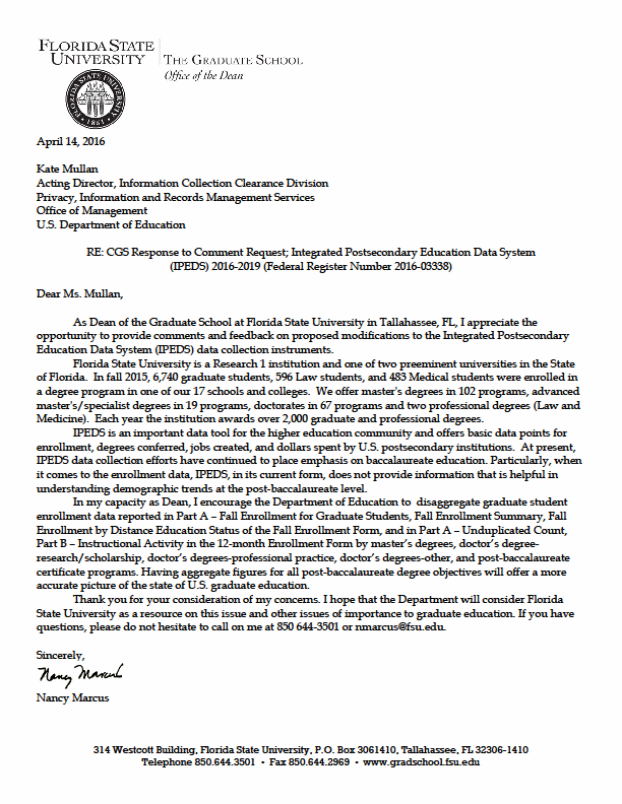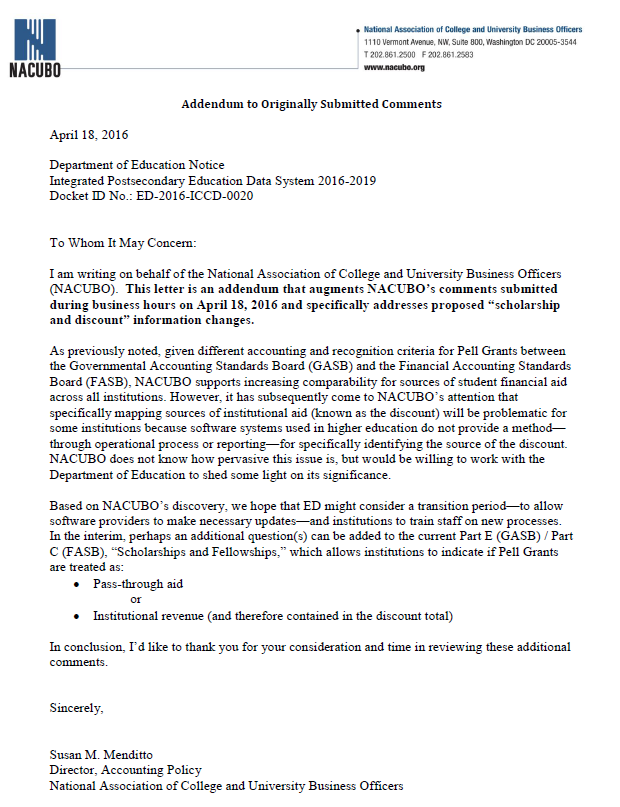IPEDS 2016-2019 Responses to 60-day Public Comments
IPEDS 2016-2019 Responses to 60-day Public Comments.docx
Integrated Postsecondary Education Data System (IPEDS) 2016-2019
IPEDS 2016-2019 Responses to 60-day Public Comments
OMB: 1850-0582
Public Comment Received During the 60-day Comment Period
and NCES Responses
June 2016
Integrated Postsecondary Education Data System (IPEDS) 2016-19
ED-2016-ICCD-0020 Comments on FR Doc # 2016-03338
Comments related to moving AL questions & study abroad instructions (Comment numbers 6, 7, 8)
Document:
ED-2016-ICCD-0020-0006
Name:
Anonymous
All
library questions that are proposed to be added to the Institutional
Characteristics survey should instead be moved to the library survey.
It will be confusing for people to know or locate
which survey
contains the specific library information they need if is in
different surveys.
Since there is a stand-alone Library survey,
it would be best for it to contain all the questions
about
school libraries.
Document:
ED-2016-ICCD-0020-0007
Name:
Anonymous
Please
move all questions about the library to the Library survey instead of
the Institutional Characteristics survey. Since there is a
stand-alone library survey, people seeking information about the
library would look for data in that survey instead of the
Institutional Characteristics survey.
The deletion of the
wording to exclude students who are attending at a branch campus is
confusing to schools that have an additional location outside of the
United States. These schools have three situations that should be
addressed in the instructions of each survey if students should be
included or excluded. If there are any of situations please make sure
to clarify that in the instructions. It would be helpful if you could
mention in the FAQs why this wording was changed. The three
situations are:
1. Student is admitted to and will attend
all years at your school's foreign location.
2. Student is
admitted into the foreign location of your university but attends the
USA location for a semester - Include only during the visiting
semester in the USA or exclude this semester? If these students are
to be included in only some some surveys please make sure to note
that in the instructions.
3. Student is admitted into and
attends the USA location but takes a semester at a foreign location
that may or may not be associated with your school.
Document: ED-2016-ICCD-0020-0008
Name: Anonymous
Please
elaborate in the directions what students should be included in each
survey when a school has a location outside of the United States. The
deletion in the instructions to exclude students enrolled in a branch
campus makes it confusing to determine if students should be included
or excluded from the various surveys under these conditions:
Please
clarify if students should be included or excluded for the following
scenarios for schools that have locations in the USA and another
country:
1. Student is admitted to and will attend all
years at the foreign location.
2. Student is admitted into
the foreign location but attends the USA location for a semester -
Include only during the visiting semester in the USA or exclude this
semester?
3. Student attends the USA location but takes a
semester at a foreign location that may or may not be associated with
your school.
Response:
Dear Anonymous,
Thank you for your feedback dated February 24, 2016, responding to a request for comments on proposed changes to the Department of Education’s Integrated Postsecondary Education Data System (IPEDS) published in the Federal Register. The National Center for Education Statistics (NCES) appreciates your interest in IPEDS. The Paperwork Reduction Act (PRA) provides an opportunity for an open and public comment period where comments on collections can be made. We are grateful for this process and your comment.
Thank you for submitting your comment proposing to move questions related to academic libraries from the Institutional Characteristics component to the Academic Libraries component because of confusion over library information being located in two surveys. However, it is necessary that questions about academic libraries span across both surveys because the two surveys are collecting different types of information.
The Institutional Characteristics component’s purpose is to collect information about an institution's mission, student services, and student charges. The library questions included within this component are intended to collect information on the library services offered to students. The Institutional Characteristics component allows institutions with or without an academic library the ability to provided information on what/if library services are offered to their students.
The Academic Libraries component’s purpose is to collect information on library collections, expenses, and types of library services provided by degree-granting postsecondary institutions with a library. The academic library questions asked in the Institution Characteristics component do not align with the purposes of the Academic Libraries survey. Thus, their requirement in the Institutional Characteristics component is necessary since they align with the purpose of that survey component.
In response to the comments about study abroad students, NCES will create a Study Abroad Tip Sheet, to be posted to the page http://nces.ed.gov/ipeds/Section/Data_tip_sheet, that will better clarify when and how these students will be reported for each of the survey components. The tip sheet will include the following table.
Reporting study abroad students enrolled for credit at the institution, by role of the institution and IPEDS survey component
Survey component |
Role of the institution where the student is enrolled for credit |
|
Home institution |
Host institution |
|
Fall Enrollment |
Include as degree-seeking only if student is taking courses for credit at the institution or if the institution provides the instructional resource (classroom, instructors) at the foreign location; Include in retention calculations (freshman study abroad students can be added to the first-time cohort and sophomore study abroad students can be considered part of the retained cohort) |
Include as non-degree-seeking; Exclude from retention calculations |
12-month Enrollment |
Include in enrollment if student is taking courses for credit at the institution or if the institution provides the instructional resource (classroom, instructors) at the foreign location |
Include in enrollment |
Graduation Rates and Graduation Rates 200% |
Include in first-time cohort and completion |
Exclude from first-time cohort and completion |
Outcome Measures |
Include in first-time cohort and outcomes |
Exclude from first-time cohort and outcomes |
Institutional Characteristics |
Exclude students’ cost of attendance |
Exclude students’ cost of attendance |
Student Financial Aid |
Exclude students’ cost of attendance |
Exclude students’ cost of attendance |
Finance |
Include in FTE and scholarships/fellowships processed by the institution |
Include in FTE and scholarships/fellowships processed by the institution |
NOTE: For student to be reported by either home or host institution, the student must be enrolled for credit at that institution. Study abroad students can include U.S. students taking courses abroad or foreign students taking courses at a U.S. institution
Home institution – student is seeking a degree at that institution but may be taking classes in a foreign location
Host institution – student is visiting and taking courses for credit, but not seeking a degree at that institution
Answers to the scenarios posed in the comment can be found in the table, which includes more details about the role of the U.S. institution and how students can be reported under several components.
Sincerely Yours,
Richard J. Reeves
Postsecondary Branch Chief
Administrative Data Division
Comments related to interlibrary loan fees on AL (Comment numbers 9, 10)
Document: ED-2016-ICCD-0020-0009
Name: Robert Dugan
The
Department of Education is especially interested in public comment
addressing the following issues: 4) how might the Department enhance
the quality, utility, and clarity of the information to be
collected.
Academic Library component;
Library
Expenses
Materials/services expenses
All other
materials/service cost
The instructions state to "Include
fees paid to bibliographic utilities if the portion paid for the
interlibrary loan can be separately counted." is confusing
concerning interlibrary loan fees. Suggest changing the instructions
to read: "Include the interlibrary loan fees paid to
bibliographic utilities if the interlibrary loan costs paid can be
separated out from the expenses paid to the bibliographic utility."
Document: ED-2016-ICCD-0020-0010
Name: Robert Dugan
The
Department of Education is especially interested in public comment
addressing the following issues: 4) how might the Department enhance
the quality, utility, and clarity of the information to be
collected.
Academic Libraries component
Library
Expenses
All other operations and maintenance expenses
The
instructions state to "Report any other maintenance expenses
that have not already been reported in this section. Include:
National, regional, and local bibliographic utilities, networks and
consortia.
Suggest that this bullet point in the
instructions be expanded to include "If interlibrary loan is
included as an expense with bibliographic utilities but the costs
cannot be separated out, include the interlibrary loan costs here
with the library's expenses of the bibliographic utilities."
Response
Dear Mr. Dugan,
Thank you for your feedback posted March 14, 2016 responding to a request for comments on proposed changes to the Department of Education’s Integrated Postsecondary Education Data System (IPEDS) 2016-19. The National Center for Education Statistics (NCES) appreciates your interest in IPEDS. The Paperwork Reduction Act (PRA) provides an opportunity for an open and public comment period where comments on collections can be made. We are grateful for this process and your comment.
Thank you for submitting your comment proposing to clarify instructions related to Library Expenses – other materials/service cost in the Academic Libraries component because the current instructions are confusing concerning interlibrary loan fees. In response to your recommendations, NCES will update their instructions on reporting “other materials/service cost” from stating, “Include fees paid to bibliographic utilities if the portion paid for the interlibrary loan can be separately counted” to now state, “Include the interlibrary loan fees paid to bibliographic utilities if the interlibrary loan costs paid can be separated out from the expenses paid to the bibliographic utility.” Also, NCES will update their instructions on reporting all other operations and maintenance expenses by including the following statement, “If interlibrary loan is included as an expense with bibliographic utilities but the costs cannot be separated out, include the interlibrary loan costs here with the library's expenses of the bibliographic utilities." We believe that the change in instructions should result in a better understanding of the survey question and provide improved accuracy and quality of the data being reported. Thank you again for your feedback.
Sincerely Yours,
Richard J. Reeves
Postsecondary Branch Chief
Administrative Data Division
Comments related to national level collections on AL (Comment numbers 11, 14)
Document: ED-2016-ICCD-0020-0011
Name: Robert Dugan
Academic
Libraries Component
Library Collections
Books
Digital/Electronic
Current instructions state to "Include
e-book titles in aggregated sets in which the library selected the
aggregator even if not each individual e-book title."
A
problem may occur when academic libraries include counts of books in
national-level collections for which they have access. These counts
overstate the e-books titles under the administrative control of the
library.
Suggest adding the following language in the
instructions: "Do not count e-book titles from the HathiTrust,
Center for Research Libraries, Internet Archive, and similar
collections unless the library owns the digitized item and it is
accessible under current copyright law."
Document: ED-2016-ICCD-0020-0014
Name: W. Bede Mitchell
I
second this suggestion:
Academic Libraries Component
Library
Collections
Books Digital/Electronic
Current
instructions state to "Include e-book titles in aggregated sets
in which the library selected the aggregator even if not each
individual e-book title."
A problem may occur when
academic libraries include counts of books in national-level
collections for which they have access. These counts overstate the
e-books titles under the administrative control of the
library.
Suggest adding the following language in the
instructions: "Do not count e-book titles from the HathiTrust,
Center for Research Libraries, Internet Archive, and similar
collections unless the library owns the digitized item and it is
accessible under current copyright law."
Response
Dear Mr. Dugan and Mr. Mitchell,
Thank you for your feedback posted March 14, 2016 and March 16, 2016 responding to a request for comments on proposed changes to the Department of Education’s Integrated Postsecondary Education Data System (IPEDS) 2016-19. The National Center for Education Statistics (NCES) appreciates your interest in IPEDS. The Paperwork Reduction Act (PRA) provides an opportunity for an open and public comment period where comments on collections can be made. We are grateful for this process and your comment.
Thank you for submitting your comments proposing to not count e-book titles from national collections (e.g. Hathi Trust or Internet Archive) unless the library owns the digitized item and it is accessible under current copyright law. In response to your recommendation, NCES plans to exclude e-book titles from national collections unless the library owns the digitized item and it is accessible under current copyright law. The intent of the AL component is for institutions to report what is in their library collection. While e-book titles from national collections (such as Hathi Trust) may be in an institutions discovery tool, we are asking that an institution report the number of titles for which they have "item" records. Including e-book titles from national collections inflate the overall counts for most institutions. This guidance was provided by Association of College and Research Libraries (ACRL) and Association of Research Libraries (ARL) Joint Advisory Task Force on IPEDS/AL Component that advises IPEDS on the AL component and NCES accepted their recommendation to not include these items. We believe that the changes in definitions/instructions discussed above should result in a better understanding of the survey questions and provide improved accuracy and quality of the data being reported. Thank you again for your feedback.
Sincerely Yours,
Richard J. Reeves
Postsecondary Branch Chief
Administrative Data Division
Comments related to reporting physical media on AL (Comment numbers 12, 40)
Document: ED-2016-ICCD-0020-0012
Name: Robert Dugan
The
Department of Education is especially interested in public comment
addressing the following issues: 4) how might the Department enhance
the quality, utility, and clarity of the information to be
collected.
Academic Libraries Component
Library
Collections
Media - Physical
The opening line of the
instructions states "Report the number of titles of media
materials . . ." but the last line of the same paragraph reads
"Items packaged together as a unit and checked out as a unit are
counted as one physical unit."
The last line is
confusing since libraries are instructed to only report titles.
Suggestion is to delete the last sentence, "Items
packaged together as a unit (e.g. two CD-ROMs for one record book)
and checked out as a unit are counted as one physical unit."
from the instructions.
Document:
ED-2016-ICCD-0020-0040
Name:
Linda Miller
About
the definition for Physical Media in the Academic Libraries survey:
-Please see a possible suggestion below to clarify the
definition. (The text "displayed by visual projection or
magnification, or through sound reproduction, or both" is part
of the definition for audiovisual materials, and could be confusing
here.)
-The serial and microform formats are secondary to type
of material (e.g., you can have a serial map, a serial text-based
microform, a microform map). May respondents ignore any duplication
this might cause in within the media count, or between the media and
serial counts (most here caused by microforms)?
-I wonder if it
would be more helpful to data users to have some of these counts
separated.
Physical Media
Report the number of titles
of media materials. ADD: INCLUDE AUDIOVISUAL MATERIALS, CARTOGRAPHIC
MATERIALS, GRAPHIC MATERIALS AND THREE-DIMENSIONAL ARTEFACTS AND
REALIA. [REMOVE: THAT ARE DISPLAYED BY VISUAL PROJECTION OR
MAGNIFICATION, OR THROUGH SOUND REPRODUCTION, OR BOTH, INCLUDING
SOUND RECORDINGS, MOTION PICTURES AND VIDEO RECORDINGS, MICROFORMS,
CARTOGRAPHIC AND GRAPHIC MATERIALS. ITEMS PACKAGED TOGETHER AS A UNIT
(E.G., TWO CD-ROMS FOR ONE RECORD BOOK) AND CHECKED OUT AS A UNIT ARE
COUNTED AS ONE PHYSICAL UNIT.]
Response
Dear Mr. Dugan and Ms. Miller,
Thank you for your feedback posted on March 14, 2016 and April 6, 2016 responding to a request for comments on proposed changes to the Department of Education’s Integrated Postsecondary Education Data System (IPEDS) 2016-19. The National Center for Education Statistics (NCES) appreciates your interest in IPEDS. The Paperwork Reduction Act (PRA) provides an opportunity for an open and public comment period where comments on collections can be made. We are grateful for this process and your comment.
Thank you for submitting your comments proposing to clarify instructions related to Physical Media in the Academic Libraries component, since the current instructions are confusing because libraries are instructed to only report titles and the AL component now includes serials. In response to your recommendations, NCES will update their instructions on reporting physical media to state, “Report the number of titles of media materials. Include audio visual materials, cartographic materials, graphic materials and three-dimensional artefacts and realia”
In response to clarifying how institutions should report media and serials, NCES is working with the Association of College and Research Libraries (ACRL) and Association of Research Libraries (ARL) Joint Advisory Task Force on IPEDS/AL Component that advises IPEDS on the AL component to ensure that survey tips, and FAQs are provided, along with survey instructions and definitions, that provides guidance on what items are included in each category. However, NCES currently does not have plans to have separate counts for types of materials categorized within media because of the burden that it would create on institutions reporting to IPEDS. We believe that the change in instructions and additional guidance provided on the AL component for media and serials should result in a better understanding of the survey questions and provide improved accuracy and quality of the data being reported. Thank you again for your feedback.
Sincerely Yours,
Richard J. Reeves
Postsecondary Branch Chief
Administrative Data Division
Comment related to interlibrary services on AL (Comment number 13)
Document:
ED-2016-ICCD-0020-0013
Name:
David Larson
The Department of Education is especially interested in public comment addressing the following issues: 4) how might the Department enhance the quality, utility, and clarity of the information to be collected.
Academic
Library component:
Section 1
Does your institution have
interlibrary services?
"Interlibrary services"
is not defined and should be replaced with the more-commonly used
"interlibrary loan services." The definition of
"interlibrary loan services" should reference Section 1.0
of the Interlibrary Loan Code for the United States
(http://www.ala.org/rusa/resources/guidelines/interlibrary):
"Interlibrary loan is the process by which a library requests
material from, or supplies material to, another library" where
"'material' includes books, audiovisual materials, and other
returnable items as well as copies of journal articles, book
chapters, excerpts, and other non-returnable items."
Response
Dear Mr. Larson,
Thank you for your feedback posted March 15, 2016 responding to a request for comments on proposed changes to the Department of Education’s Integrated Postsecondary Education Data System (IPEDS) 2016-19. The National Center for Education Statistics (NCES) appreciates your interest in IPEDS. The Paperwork Reduction Act (PRA) provides an opportunity for an open and public comment period where comments on collections can be made. We are grateful for this process and your comment.
Thank you for submitting your comment proposing to rename and redefine interlibrary services to interlibrary loan services in Section 1 of the Academic Libraries (AL) component because the current term is not commonly used. In response to your recommendation, NCES will change the terminology in Section 1 of the AL component from interlibrary services to interlibrary loan services in order to align the AL survey with language commonly used in the AL field. Also, NCES will provide clarification to the term interlibrary loan services by aligning the definition with what is commonly used in the field by referencing Section 1.0 of the Interlibrary Loan Code for the United States stating, “Interlibrary loan is the process by which a library requests material from, or supplies material to, another library" where "'material' includes books, audiovisual materials, and other returnable items as well as copies of journal articles, book chapters, excerpts, and other non-returnable items." We believe that the change in terminology should result in a better understanding of the survey questions and provide improved accuracy and quality of the data being reported. Thank you again for your feedback.
Sincerely Yours,
Richard J. Reeves
Postsecondary Branch Chief
Administrative Data Division
Comments related to reporting serials on AL (Comment numbers 15, 16, 17, 19, 20, 22)
Document:
ED-2016-ICCD-0020-0015
Name:
Susanna Smith
For
the serials "Add "Serials" row to Library Collections
and include in the calculated total for circulation", I am
concerned because the instructions are not clear. We subscribe to
thousands of serials through our databases, which are already covered
in full. Is this meant to cover those serials we subscribe to
separately? Would this include paid digital subscriptions to
newspaper and serial websites, like the Chronicle of Higher
Education's site?
If this is the case, the instructions
need to be modified: Serials - Report the number of publications
issued in successive parts, usually at regular intervals, and, as a
rule, intended to be continued indefinitely. Serial subscriptions
include periodicals, newspapers, annuals (reports, yearbooks, etc.),
memoirs, proceedings, and transactions of societies. This does not
include serials accessed through a database, but those purchased
separately. Include (or do not include!) paid access to websites that
house the content of particular serials (ie: "The Chronicle of
Higher Education")
If I have misunderstood, then the
instructions need to be more specific about WHERE you want us to
gather all the serials data
Document:
ED-2016-ICCD-0020-0016
Name:
Robert Dugan
The
Department of Education is especially interested in public comment
addressing the following issues: 4) how might the Department enhance
the quality, utility, and clarity of the information to be
collected.
Academic Libraries component
Library
Collections
Serials, Physical
The proposed
instructions for Serials, Physical states: "Report the number of
publications issued in successive parts, usually at regular
intervals, and, as a rule, intended to be continued indefinitely.
Serial subscriptions include periodicals, newspapers, annuals
(reports, yearbooks, etc.), memoirs, proceedings, and transactions of
societies."
For the instructions:
1. clarify
that libraries report the number of serials publications titles. If
titles are not included in this instruction, libraries may report the
number of serial issues or serial volumes (e.g., there may be 12
volumes for one serial publication title). The reporting of titles
for serials publications parallels the current instructions
concerning microforms (Media, Physical) which asks libraries to
report the number of titles rather than the number of units (e,g.,
reels of microfilm).
2. emphasize that bound serial volumes are
reported as physical books. Libraries are likely to report the number
of bound serial volumes in the Serials, Physical box. That may be
IPEDS' intent. If so, then the current text instructions for Books,
Physical needs to be revised to instruct respondents to report bound
physical serial volumes as Serials, Physical.
Document:
ED-2016-ICCD-0020-0017
Name:
Robert Dugan
The
Department of Education is especially interested in public comment
addressing the following issues: 4) how might the Department enhance
the quality, utility, and clarity of the information to be
collected.
Academic Libraries component
Library
Collections
Serials, Digital/Electronic
The proposed
instructions for Serials, Digital/Electronic are not included in the
proposed survey revision. Suggest that IPEDS develop these
instructions with assistance from the ACRL, ALA and ARL Joint
Advisory Task Force on IPEDS/AL Component New Data Elements and
Definitions.
Document:
ED-2016-ICCD-0020-0019
Name:
Mary Jane Petrowski
I
support Robert Dugan's suggestion below:
Academic
Libraries component
Library Collections
Serials,
Physical
The proposed instructions for Serials, Physical
states: "Report the number of publications issued in successive
parts, usually at regular intervals, and, as a rule, intended to be
continued indefinitely. Serial subscriptions include periodicals,
newspapers, annuals (reports, yearbooks, etc.), memoirs, proceedings,
and transactions of societies."
For the
instructions:
1. clarify that libraries report the number of
serials publications titles. If titles are not included in this
instruction, libraries may report the number of serial issues or
serial volumes (e.g., there may be 12 volumes for one serial
publication title). The reporting of titles for serials publications
parallels the current instructions concerning microforms (Media,
Physical) which asks libraries to report the number of titles rather
than the number of units (e,g., reels of microfilm).
2.
emphasize that bound serial volumes are reported as physical books.
Libraries are likely to report the number of bound serial volumes in
the Serials, Physical box. That may be IPEDS' intent. If so, then the
current text instructions for Books, Physical needs to be revised to
instruct respondents to report bound physical serial volumes as
Serials, Physical.
Document:
ED-2016-ICCD-0020-0020
Name:
Mary Jane Petrowski
I support Robert Dugan's comment below:
The Department of Education is especially interested in public comment addressing the following issues: 4) how might the Department enhance the quality, utility, and clarity of the information to be collected.
Academic Libraries component
Library Collections
Serials, Digital/Electronic
The proposed instructions for Serials, Digital/Electronic are not included in the proposed survey revision. Suggest that IPEDS develop these instructions with assistance from the ACRL, ALA and ARL Joint Advisory Task Force on IPEDS/AL Component New Data Elements and Definitions.
Document:
ED-2016-ICCD-0020-0022
Name:
Terri Fishel
By
adding Serials to the IPEDS academic library data form, the
Definition for Physical Books needs to be addressed. The form for
2015-16 states for Physical Books (include government documents and
serial backfiles) - so will serial backfiles be in Serial count or
Book count?
Strongly recommend that all definitions for
the IPEDS collection are consistent with the ACRL Annual Survey
definitions. The current ACRL survey allows for a single form to be
filled in and the IPEDS are extracted as a separate file. Consistency
between the two data collections would allow for fewer questions and
a better understanding of what is being collected.
Response
Dear Ms. Smith, Mr. Dugan, Ms. Petrowski, and Ms. Fishel,
Thank you for your feedback submitted during the 60-day review process, responding to a request for comments on proposed changes to the Department of Education’s Integrated Postsecondary Education Data System (IPEDS) 2016-19. The National Center for Education Statistics (NCES) appreciates your interest in IPEDS. The Paperwork Reduction Act (PRA) provides an opportunity for an open and public comment period where comments on collections can be made. We are grateful for this process and your comment.
Thank you for submitting your comment on the addition of collecting data on physical and digital/electronic serials and the instructions that accompany these additions in the Academic Libraries survey component. NCES is aware that the alignment of our definitions and instructions with the standards within the academic library field for materials classified in physical and digital/electronic collection and circulation is of upmost importance.
NCES is currently working with the Association of College and Research Libraries (ACRL) and Association of Research Libraries (ARL) Joint Advisory Task Force on IPEDS/AL Component that advises IPEDS on the AL component to define and provide guidance on reporting serials in the Academic Libraries component, as well as ensuring all our definitions and instructions align with other items collected in the AL component and with the expected standards within the academic library field.
The AL component will ask that institutions report the number of physical and digital/electronic serial titles that are accessible to users through the library’s catalog or discovery system. A serial is a publication in any medium issued in successive parts bearing numerical or chronological designations and intended to be continued indefinitely. This definition includes, in any format, periodicals, newspapers, and annuals (reports, yearbooks, etc.); the journals, memoirs, proceedings, transactions, etc. of societies; and numbered monographic series. An e-serial is a periodical publication that is published in digital form to be displayed on a computer screen. The AL component will also provide additional guidance that institutions report serial titles and not subscriptions, include count of ceased titles if available, and include open access (OA) titles if the individual titles are searchable through the library’s catalog or discovery system. We believe that the results in this collaboration with the ACRL and ARL Joint Advisory Task Force should result in a better understanding of how to report serials and provide improved accuracy and quality of the data being reported. Thank you again for your feedback.
Sincerely Yours,
Richard J. Reeves
Postsecondary Branch Chief
Administrative Data Division
Comments related to databases and discovery systems on AL (Comment numbers 18, 21)
Document:
ED-2016-ICCD-0020-0018
Name:
Robert Dugan
The
Department of Education is especially interested in public comment
addressing the following issues: 4) how might the Department enhance
the quality, utility, and clarity of the information to be
collected.
Academic Libraries component
Library
Collections
Databases, Digital/Electronic
A database
is defined in the instructions. The text also instructs the
respondent to not include discovery systems in the count of
databases. Suggest that IPEDS:
a. link the phrase "discovery
tool" to the Glossary at this instance in the instructions
OR
b. include the Glossary definition for discovery system
at this point in the instructions
OR
c. provide a brief or
otherwise truncated definition for discovery system at this point in
the instructions, such as "Discovery systems are end-user
software-based platforms which enable users to simultaneously search
metadata in a unified index of local library holdings, electronic
collections, and external indexes, and presents search results in a
single interface."
Docket:
ED-2016-ICCD-0020
Integrated
Postsecondary Education Data System (IPEDS) 2016-2019
Document:
ED-2016-ICCD-0020-0021
Name:
Mary Jane Petrowski
I
support the comment below:
The Department of Education is
especially interested in public comment addressing the following
issues: 4) how might the Department enhance the quality, utility, and
clarity of the information to be collected.
Academic
Libraries component
Library Collections
Databases,
Digital/Electronic
A database is defined in the
instructions. The text also instructs the respondent to not include
discovery systems in the count of databases. Suggest that IPEDS:
a.
link the phrase "discovery tool" to the Glossary at this
instance in the instructions
OR
b. include the Glossary
definition for discovery system at this point in the
instructions
OR
c. provide a brief or otherwise truncated
definition for discovery system at this point in the instructions,
such as "Discovery systems are end-user software-based platforms
which enable users to simultaneously search metadata in a unified
index of local library holdings, electronic collections, and external
indexes, and presents search results in a single interface."
Response
Dear Mr. Dugan and Ms. Petrowski,
Thank you for your feedback posted March 21, 2016 and March 22, 2016 responding to a request for comments on proposed changes to the Department of Education’s Integrated Postsecondary Education Data System (IPEDS) 2016-19. The National Center for Education Statistics (NCES) appreciates your interest in IPEDS. The Paperwork Reduction Act (PRA) provides an opportunity for an open and public comment period where comments on collections can be made. We are grateful for this process and your comment.
Thank you for submitting your comments proposing to clarify instructions related to databases and discovery systems in the Academic Libraries component. In response to your recommendation, NCES will provide a link to the glossary definition of discovery systems in the Digital/Electronic Database section of the Academic Libraries instructions that state, “Do not include discovery systems in the count of databases.” Also, NCES will provide clarification to the terminology of databases and discovery system by providing an FAQ that discusses the difference between the two terms. We believe that the change in instructions should result in a better understanding of the survey questions and provide improved accuracy and quality of the data being reported. Thank you again for your feedback.
Sincerely Yours,
Richard J. Reeves
Postsecondary Branch Chief
Administrative Data Division
Comment related to schedule materials and links in collection system (Comment number 23)
Name: Jarod Hightower-Mills
I
would strongly recommend that IPEDS in the future make sure that the
dates for the next collection period before the Fall Collection
period closes. Institutions and departments involved in collecting
and reporting this data needs to plan for when they need to have
resources available to respond to next year's surveys.
In
addition, the survey guides should be revised to make them for
user-friendly. If possible, the survey data entry GUI should link
directly to relevant information so that people who are new to IPEDS
reporting can complete the survey accurately and efficiently.
Response
Dear Mr. Hightower-Mills,
Thank you for your feedback dated March 23, 2016, responding to a request for comments on proposed changes to the Department of Education’s Integrated Postsecondary Education Data System (IPEDS) published in the Federal Register. The National Center for Education Statistics (NCES) appreciates your interest in IPEDS. The Paperwork Reduction Act (PRA) provides an opportunity for an open and public comment period where comments on collections can be made. We are grateful for this process and your comment.
In regard to the comment about the collection schedule, NCES currently provides the schedule for the new collection during the Winter/Spring collection. While this may seem late, this helps to ensure that the dates for the collection are fixed and less likely to change due to unanticipated circumstances. However, the dates do follow a pattern that, assuming there are not unanticipated circumstances, can be estimated by an institution. Registration typically starts the first or second Wednesday in August, with the Fall collection opening 4 weeks after registration and lasting 6 weeks for keyholders and 8 weeks for coordinators, the Winter collection opening 6 weeks after the Fall coordinator close and lasting 9 weeks for keyholders and 11 weeks for coordinators, and the Spring collection opening at the same time as the Winter collection and lasting 18 weeks for keyholders and 20 weeks for coordinators.
In regard to the comment about the survey guide and links within the data collection system to help materials, we continuously looks at ways to improve these materials and have a number of links to the materials within the survey pages. On survey pages there are, as applicable, links to screen level instructions, glossary definitions, screen tips, and instructional videos. The Help menu includes a detailed New Keyholder Handbook, full survey materials, data collection system instructions and tutorial, flyers with more information on our training and dedicated IPEDS Help Desk, and more. NCES will continue to identify ways for improvement in this area, and will implement any identified improvements for the next OMB clearance.
Sincerely Yours,
Richard J. Reeves
Postsecondary Branch Chief
Administrative Data Division
Comments related to institutional repository on AL (Comment numbers 24, 25)
Document:
ED-2016-ICCD-0020-0024
Name:
Rachel Kirk
What is the preferred methodology for quantifying usage for Institutional Repository documents? We first considered using Bitstream views, but realized that this metric is not as analogous to full-text downloads as we originally thought. We are using Dspace for our institutional repository.
Document:
ED-2016-ICCD-0020-0025
Name:
Rachel Kirk
Please provide instructions on determining usage/circulation for documents in Institutional Repositories.
Response
Dear Ms. Kirk,
Thank you for your feedback posted March 30, 2016 responding to a request for comments on proposed changes to the Department of Education’s Integrated Postsecondary Education Data System (IPEDS) 2016-19. The National Center for Education Statistics (NCES) appreciates your interest in IPEDS. The Paperwork Reduction Act (PRA) provides an opportunity for an open and public comment period where comments on collections can be made. We are grateful for this process and your comments.
Thank you for submitting your comments regarding the collection of Institutional Repositories in the Academic Libraries (AL) component. In response to your comments and questions on providing instructions and methodology on how to report institutional repositories in the AL component, NCES does not plan to collect data on institutions repositories on the AL survey. This guidance was provided by Association of College and Research Libraries (ACRL) and Association of Research Libraries (ARL) Joint Advisory Task Force on IPEDS/AL Component that advises IPEDS on the AL component and NCES accepted their recommendation that collecting this information across all institutions is currently not viable and would increase the burden for institutions to report to IPEDS. However, NCES will clarify in the AL component’s instructions/FAQs that IPEDS does not ask institutions to report institutional repositories. We believe that not including institutional repositories will reduce the burden of institutions reporting to IPEDS and provide improved accuracy and quality of the data being reported. Thank you again for your feedback.
Sincerely Yours,
Richard J. Reeves
Postsecondary Branch Chief
Administrative Data Division
Comment related to agreement with changes on AL (Comment number 26)
Document:
ED-2016-ICCD-0020-0026
Name:
Rosanne Cordell
The changes to the Academic Libraries portion seem reasonable.
Response
Dear Ms. Cordell,
Thank you for your feedback posted March 31, 2016 responding to a request for comments on proposed changes to the Department of Education’s Integrated Postsecondary Education Data System (IPEDS) 2016-19. The National Center for Education Statistics (NCES) appreciates your interest in IPEDS. The Paperwork Reduction Act (PRA) provides an opportunity for an open and public comment period where comments on collections can be made. We are grateful for this process and your comment.
In regards to your comment stating that the changes to the Academic Libraries (AL) component are reasonable. We value your feedback and believe that the changes proposed to the Department of Education’s Integrated Postsecondary Education Data System (IPEDS) 2016-19 AL component should result in a better understanding of the survey questions and provide improved accuracy and quality of the data being reported. Thank you again for your feedback.
Sincerely Yours,
Richard J. Reeves
Postsecondary Branch Chief
Administrative Data Division
Comment related to consortia funds and reserve circulation on AL (Comment number 27)
Document:
ED-2016-ICCD-0020-0027
Name:
Steven Ovadia
1.
Please add money spent on behalf of an institution, for consortial
systems where a centralized office contributes resources
2.
Include reserve circulation as part of physical circulation.
Response
Dear Mr. Ovadia,
Thank you for your feedback posted April 1, 2016 responding to a request for comments on proposed changes to the Department of Education’s Integrated Postsecondary Education Data System (IPEDS) 2016-19. The National Center for Education Statistics (NCES) appreciates your interest in IPEDS. The Paperwork Reduction Act (PRA) provides an opportunity for an open and public comment period where comments on collections can be made. We are grateful for this process and your comment.
In regards to your comments proposing to add expenses from consortia systems that contribute resources to an institution and to include reserve circulation as part of a library’s physical circulation. The intent of Section II: Expenses of the AL component is for institutions to report funds expended by the library from its regular budget or from the institution’s budget (if library items are identifiable to report). We do not currently plan to include expenses from entities that contribute resources to the library outside of the institution. The survey’s intent is to focus on the expenses of only the institution. The one exception to this is in the case of a consortia where individual library members share all the same library resources and library budget. In this case a parent/child relationship for reporting AL data may be established if certain criteria are met.
In response to your recommendation to include reserve circulation as part of a library’s physical circulation, NCES will begin to count under initial circulation of physical items the physical-print reserve circulation (this way the initial circulation count will reflect all physical-print circulation of content whether it is part of the regular print collection or the reserve print collection). We believe that the change in collection should provide improved accuracy and quality of the data being reported. Thank you again for your feedback.
Sincerely Yours,
Richard J. Reeves
Postsecondary Branch Chief
Administrative Data Division
Comment related to volume count and national collections on AL (Comment number 28)
Document:
ED-2016-ICCD-0020-0028
Name:
Karl S
It's
time to end the "volume count" of physical books. This is
difficult to compile in modern automation systems and more or less
irrelevant when it comes to digital content. It is a leftover from an
earlier age of library comparisons that has outlived its
usefulness.
As a library administrator doing comparison
work, I want to see how many "titles" a library provides
access to, in print or digital form, broken down by formats (print
book, electronic book, print serial, electronic serial, etc.). Like
many libraries, we have overlap in titles held in print and
electronic format, etc., so the overall number of titles need not
equal the sum of titles by format.
I would also like to
see what percentage of content in a library's discovery environment
is purchased, licensed, demand-driven acquisition, or open access.
The dramatic shift in access and acquisition options is
driving innovation in library services, and we shouldn't exclude huge
swaths of library content because our definitions are wedded to an
old-fashioned model of library collections. Contrary to other
commentators who want to exclude broadly available open access titles
(e.g. Hathi Trust or Internet Archive) because they think it
"inflates" counts, I think it is interesting to know how
open access content is becoming a part of the package of services
that libraries are providing. It is helpful, however to know how much
content comes from a particular mode of acquisition/access.
Response
Dear Karl S.,
Thank you for your feedback posted April 1, 2016 responding to a request for comments on proposed changes to the Department of Education’s Integrated Postsecondary Education Data System (IPEDS) 2016-19. The National Center for Education Statistics (NCES) appreciates your interest in IPEDS. The Paperwork Reduction Act (PRA) provides an opportunity for an open and public comment period where comments on collections can be made. We are grateful for this process and your comment.
In regards to your comments proposing to: (1) stop counting volumes of physical books, (2) include percentages of content in a library’s discovery environment; and (3) include broadly available open access titles (e.g. Hathi Trust or Internet Archive) in the collection.
In response to your recommendation to stop counting volumes of physical books, NCES will change our physical book circulation definition to only include counting titles, not volumes. This will ensure that the definition for physical books aligns with the definitions of other circulation counts collected for IPEDS.
In regard to your second recommendation to include percentages of content in a library’s discovery environment, NCES does not plan to include this on the AL component. Currently, most institutions do not have a way to report this information without substantially increasing their burden to report to IPEDS. NCES will bring this topic to the Association of College and Research Libraries (ACRL) and Association of Research Libraries (ARL) Joint Advisory Task Force on IPEDS/AL Component that advises IPEDS on the AL component and discuss the possibility of adding this in the future.
Finally, in response to your recommendation to include broadly available open access titles in the collection, NCES does not plan to include this on the AL component. The intent of the AL component is for institutions to report what is in their library collection. While broadly available open access titles (such as Hathi Trust) may be in an institutions discovery tool, we are asking that an institution report the number of titles for which they have "item" records. Including broadly available open access titles inflates overall counts for most institutions since these are available to almost all of them. The IPEDS AL component is directed towards what is in the institutions library collection. This guidance was provided by Association of College and Research Libraries (ACRL) and Association of Research Libraries (ARL) Joint Advisory Task Force on IPEDS/AL Component that advises IPEDS on the AL component, and NCES accepted their recommendation to not include these items. We believe that the changes in definitions/ instructions discussed above should result in a better understanding of the survey questions and provide improved accuracy and quality of the data being reported. Thank you again for your feedback.
Sincerely Yours,
Richard J. Reeves
Postsecondary Branch Chief
Administrative Data Division
Comment related to all proposed changes (Comment number 29)
Document:
ED-2016-ICCD-0020-0029
Name:
Rachel Whittingham
These changes are thoughtful, reasonable and should be approved.
Response
Dear Ms. Whittingham,
Thank you for your feedback posted April 1, 2016 responding to a request for comments on proposed changes to the Department of Education’s Integrated Postsecondary Education Data System (IPEDS) 2016-19. The National Center for Education Statistics (NCES) appreciates your interest in IPEDS. The Paperwork Reduction Act (PRA) provides an opportunity for an open and public comment period where comments on collections can be made. We are grateful for this process and your comment.
In regards to your comment stating that the changes are thoughtful, reasonable, and should be approved. We value your feedback and believe that the changes proposed to the Department of Education’s Integrated Postsecondary Education Data System (IPEDS) 2016-19 AL component should result in a better understanding of the survey components and provide improved accuracy and quality of the data being reported. Thank you again for your feedback.
Sincerely Yours,
Richard J. Reeves
Postsecondary Branch Chief
Administrative Data Division
Comments related to digital and electronic circulation on AL (Comment numbers 30, 41)
Document:
ED-2016-ICCD-0020-0030
Name:
Susan Erickson
The question about digital/electronic circulation needs clarification. There are a number of usage statistics that could be used to determine this. Having each library make it's own judgment call about which count to use is not useful for trying to get comparative statistics across institutions.
Document:
ED-2016-ICCD-0020-0041
Name:
Linda Miller
For
the Academic Libraries survey:
Comments about the definition for
Digital/Electronic Circulation or Usage:
-The definition
is somewhat confusing on COUNTER reports. I think that MR2 use is the
same use as MR1, but broken out by media type. And, I think that BR2s
and BR1s aren't to be provided for the same use, so are not
duplicative.
-COUNTER release 4 allows for providers to provide
BR2s that report at a level more granular than section, but requires
that they report which type of use is being reported.
-It seems
that to make the data useful for benchmarking purposes (although
there will always be caveats), the national surveys should break
e-resource use into specific categories, OR request that only certain
categories be reported (i.e., COUNTER). (Possible categories?: BR1,
BR2-section, BR2-more granular or otherwise inflated, MR1or2,
sessions, views, other)
-Many universities have more than one
campus and therefore more than one IPEDS ID. However, more and more,
e-subscriptions are being purchased jointly between campuses.
Response
Dear Ms. Miller and Ms. Erickson,
Thank you for your feedback posted April 1, 2016 and April 6, 2016 responding to a request for comments on proposed changes to the Department of Education’s Integrated Postsecondary Education Data System (IPEDS) 2016-19. The National Center for Education Statistics (NCES) appreciates your interest in IPEDS. The Paperwork Reduction Act (PRA) provides an opportunity for an open and public comment period where comments on collections can be made. We are grateful for this process and your comment.
Thank you for submitting your comments proposing to clarify instructions on reporting digital/electronic circulation. In response to your comments, NCES plans to work with the Association of College and Research Libraries (ACRL) and Association of Research Libraries (ARL) Joint Advisory Task Force on IPEDS/AL Component to provide survey tips and FAQs that can give additional guidance on how institutions report digital/electronic circulation. However, NCES does not plan to ask institutions to report circulation based on specific categories nor does NCES plan on requiring institutions to report digital and electronic usage using a specified methodology. Currently, not all institutions that report data in the AL component have the ability to report digital and electronic usage based on COUNTER reports. NCES does not plan on requiring institutions to use the COUNTER method because it would increase reporting burden and possible costs to the institutions. NCES believes that asking institutions to report digital and electronic usage based on COUNTER reports (if available) and if not available, report based on other means for monitoring digital and electronic usages (downloads, session views, transaction logs, etc.) is the best avenue since there is not a preferred/consistent method of collecting digital and electronic usage in the AL field. We believe that not mandating a method of reporting digital and electronic usage will reduce the burden on institutions reporting to IPEDS. Thank you again for your feedback.
Sincerely Yours,
Richard J. Reeves
Postsecondary Branch Chief
Administrative Data Division
Comment related to reserves and renewals on AL (Comment number 31)
Document:
ED-2016-ICCD-0020-0031
Name:
Anonymous
The comment that follows pertains to the answer/submission to Total physical circulation under Section I Physical Group Information on the AL component of IPEDS...."Frustrating as this definition doesn't match the 2015-16 IPEDS instructions. I am using the 15-16 instructions meaning I should add my reserve count back in, (which was itemized/taken out in ACRL-#62). I am also leaving out my renewals with this question, again per the 15-16 instructions. If the total physical circulation should include reserves and renewals, this number should be lines 60-62 from the ACRL, not just line #60 (initial circulation)."
Response
Dear Anonymous,
Thank you for your feedback posted April 1, 2016 responding to a request for comments on proposed changes to the Department of Education’s Integrated Postsecondary Education Data System (IPEDS) 2016-19. The National Center for Education Statistics (NCES) appreciates your interest in IPEDS. The Paperwork Reduction Act (PRA) provides an opportunity for an open and public comment period where comments on collections can be made. We are grateful for this process and your comment.
Thank you for submitting your comment requesting clarification on how to report reserves and renewals in physical circulation for the AL component. In the 2015-2016 instructions, reserves and renewals were removed from reporting under physical collection in the AL survey. In 2015-16, for those libraries using the ACRL survey to also report their IPEDS AL data, they should have reported line 60 (initial circulation) as the IPEDS number and not sum lines 61 and 62 into line 60 because the IPEDS AL component did include reserves and renewals as part of a library’s physical circulation.
Based on feedback from the Association of College and Research Libraries (ACRL) and Association of Research Libraries (ARL) Joint Advisory Task Force on IPEDS/AL Component that advises IPEDS on the AL component, in 2016-17 NCES will begin to count under initial circulation of physical items the physical-print reserve circulation (this way the initial circulation count will reflect all physical-print circulation of content whether it is part of the regular print collection or the reserve print collection). However, this will not include renewals or equipment circulation counts because the practice of lending equipment varies from library to library considerably in terms of what the equipment (ranging from bicycles to cords) is making any comparison difficult. We believe that the change in collection should provide improved accuracy and quality of the data being reported. Thank you again for your feedback.
Sincerely Yours,
Richard J. Reeves
Postsecondary Branch Chief
Administrative Data Division
Comments related to print photographs on AL (Comment numbers 32, 34, 45)
Document:
ED-2016-ICCD-0020-0032
Name:
Robert Dugan
Academic
Library Component
Library Collections
Physical Books
The
instructions ask that responders "Include print photographs,
duplicates and bound volumes of periodicals and music
scores."
Please reconsider the inclusion of print
photographs in reporting in Library Collections
Document:
ED-2016-ICCD-0020-0034
Name:
Linda Miller
Academic
Libraries
Section I
Library
Collections/Circulation
Definition for Physical Books
Please
remove the phrase "print photographs" in caps below. It
doesn't appear to be part of the NISO definition, and is potentially
confusing.
Physical Books (include government documents
and serial backfiles) - Report the number of volumes using the
ANSI/NISO Z39.7-2013 definition for volume, which is as follows: A
single physical unit of any printed, typewritten, handwritten,
mimeographed, or processed work, distinguished from other units by a
separate binding, encasement, portfolio, or other clear distinction,
which has been cataloged, classified, and made ready for use, and
which is typically the unit used to charge circulation transactions.
Include PRINT PHOTOGRAPHS, duplicates and bound volumes of
periodicals and music scores. For purposes of this questionnaire,
unclassified bound serials arranged in alphabetical order are
considered classified. Exclude microfilms, maps, nonprint materials,
and uncataloged items. Include Government document volumes that are
accessible through the library's catalogs regardless of whether they
are separately shelved. "Classified" includes documents
arranged by Superintendent of Documents, CODOC, or similar numbers.
"Cataloged" includes documents for which records are
provided by the library or downloaded from other sources into the
library's card or online catalogs.
Document:
ED-2016-ICCD-0020-0045
Name:
Steve Hiller
Physical books includes photographs and Physical Media includes graphic materials. The definition provided for graphic materials includes photographs. Photographs have traditionally been counted as physical media/graphic materials and recommend that they are part of that category and not counted under physical books.
Response
Dear Mr. Dugan, Ms. Miller, and Mr. Hiller,
Thank you for your feedback posted April 4, 2016 and April 8, 2016 responding to a request for comments on proposed changes to the Department of Education’s Integrated Postsecondary Education Data System (IPEDS) 2016-19. The National Center for Education Statistics (NCES) appreciates your interest in IPEDS. The Paperwork Reduction Act (PRA) provides an opportunity for an open and public comment period where comments on collections can be made. We are grateful for this process and your comments.
Thank you for submitting your comments proposing to remove reporting print photographs in physical books in the Academic Libraries (AL) component. In response to your recommendations, NCES will remove reporting print photographs in physical books because we already ask institutions to report graphic material (including photographs) in physical media. We believe that the change in instructions should result in a better understanding of the survey questions and provide improved accuracy and quality of the data being reported. Thank you again for your feedback.
Sincerely Yours,
Richard J. Reeves
Postsecondary Branch Chief
Administrative Data Division
Comment related to combining reporting of restricted & unrestricted institution grants (Comment number 33)
Document: ED-2016-ICCD-0020-0033
Name:
Vincent Castano
Having reviewed the proposed changes, I see no adverse impact for gathering the required data at my institution. I do have a concern regarding changes to the Finance portions; specifically, the combination of unrestricted and restricted data for reporting purposes. Annual Title III applications request data elements that include these categories. By combining these figures, I am curious as to whether the combined data will adversely affect data reporting from these categories.
Response
Dear Mr. Castano,
Thank you for your feedback dated April 04, 2016, responding to a request for comments on proposed changes to the Department of Education’s Integrated Postsecondary Education Data System (IPEDS) published in the Federal Register. The National Center for Education Statistics (NCES) appreciates your interest in IPEDS. The Paperwork Reduction Act (PRA) provides an opportunity for an open and public comment period where comments on collections can be made. We are grateful for this process and your comment.
NCES has requested that “institution grants (unrestricted)” and “institution grants (restricted)” be combined into one field called “institution grants (restricted and unrestricted)” on the Scholarship/Fellowship portion of the Finance survey. This change will only impact the reporting of institution grants on the Scholarship/Fellowship screen and will not affect the reporting of unrestricted or restricted data on any other portion of the Finance survey (e.g., unrestricted or restricted revenues or net assets).
Additionally, Title III applications typically pull data from the Expense screen of the Finance survey, which will not be impacted by the change to the Scholarship/Fellowship screen. As such, we do not believe that the requested change to combine “institution grants (unrestricted)” and “institution grants (restricted)” into one field will adversely affect data reporting for Title III applications.
Sincerely Yours,
Richard J. Reeves
Postsecondary Branch Chief
Administrative Data Division
Comment related to open access on AL (Comment number 35)
Document:
ED-2016-ICCD-0020-0035
Name:
Anonymous
The definition for Digital/Electronic Books does not address open access items. It is only addressed in the FAQ. It would make things easier for users, and more consistent for reporting, if it was included in the definition.
Response
Dear Anonymous,
Thank you for your feedback posted April 5, 2016 responding to a request for comments on proposed changes to the Department of Education’s Integrated Postsecondary Education Data System (IPEDS) 2016-19. The National Center for Education Statistics (NCES) appreciates your interest in IPEDS. The Paperwork Reduction Act (PRA) provides an opportunity for an open and public comment period where comments on collections can be made. We are grateful for this process and your comment.
In response to your recommendation, NCES will address in the definition/instructions for digital/electronic books how to report open access items. While NCES does allow open access items to be included if the individual titles are searchable through the library’s catalog or discovery system, broadly available open access titles will not be to include in the AL component. The intent of the AL component is for institutions to report what is in their library collection. While broadly available open access titles (such as Hathi Trust) may be in an institutions discovery tool, we are asking that an institution report the number of titles for which they have "item" records. Including broadly available open access titles inflates the overall counts for most institutions since these are available to almost all of them. The IPEDS AL component is directed more towards what is in the institutions library collection. This guidance was provided by Association of College and Research Libraries (ACRL) and Association of Research Libraries (ARL) Joint Advisory Task Force on IPEDS/AL Component that advises IPEDS on the AL component and NCES accepted their recommendation to not include these items. We believe that the changes in definitions/instructions discussed above should result in a better understanding of the survey questions and provide improved accuracy and quality of the data being reported. Thank you again for your feedback.
Sincerely Yours,
Richard J. Reeves
Postsecondary Branch Chief
Administrative Data Division
Comment related to material expenditures on AL (Comment number 36)
Document:
ED-2016-ICCD-0020-0035
Name:
Linda Miller
Some
possible suggestions to clarify the Materials Expenditures
definitions. Possible additions in caps; possible text to remove in
caps in brackets.
One-time purchases of books, serial
back-files, and other materials
Provide the cost of one-time
purchases of books, serial backfiles, and other materials. Report
expenses for published materials in all formats including archives
and special collections [REMOVE: EXCEPT CURRENT SUBSCRIPTIONS TO
SERIALS]. Include one-time acquisitions ...
Ongoing
commitments to subscriptions
Report expenses for ongoing
COMMITMENTS [REMOVE: SUBSCRIPTIONS TO SERIALS] in all formats,
including duplicates, for all outlets. THIS INCLUDES SERIALS AND ANY
OTHER ITEMS COMMITTED TO ANNUALLY, AS WELL AS ANNUAL E-PLATFORM OR
ACCESS FEES. These are publications issued in successive parts,
usually at regular intervals, and, as a rule, intended to be
continued indefinitely. PRINT-BASED Serial subscriptions include
periodicals, newspapers, annuals (reports, yearbooks, etc.), memoirs,
proceedings, and transactions of societies. Include the costs of
electronic serials bought in aggregations and serial packages.
Include abstracting and indexing services and any database that
requires an annual subscription fee. [REMOVE-ADDED ABOVE: INCLUDE
ANNUAL ELECTRONIC PLATFORM OR ACCESS FEES.] Do not include
subscription fees if THEY ARE [REMOVE: IT'S] part of an annual
consortium fee. Government documents received serially are included
if they are accessible through the library's catalog.
All
other materials/service cost (line 22)
Report additional
materials/service costs that have not already been reported in this
section.
Other materials may include:
-Document
delivery/interlibrary ...
-Other expenses for information
resources. [REMOVE: REPORT EXPENSES SUCH AS THOSE FOR CARTOGRAPHIC
MATERIALS AND MANUSCRIPTS*] Include copyright fees and fees for
database searches, e.g. (Lexis-Nexis).
*A comment about
the last suggestion above: It seems, by definition, that expenses for
maps and manuscripts should be included in the first 2 measures and
not this last measure. Not sure what "costs such as" means
in that sentence
Response
Dear Ms. Miller,
Thank you for your feedback posted April 5, 2016 responding to a request for comments on proposed changes to the Department of Education’s Integrated Postsecondary Education Data System (IPEDS) 2016-19. The National Center for Education Statistics (NCES) appreciates your interest in IPEDS. The Paperwork Reduction Act (PRA) provides an opportunity for an open and public comment period where comments on collections can be made. We are grateful for this process and your comment.
In response to your suggestions and based on feedback from the Association of College and Research Libraries (ACRL) and Association of Research Libraries (ARL) Joint Advisory Task Force on IPEDS/AL Component that advises IPEDS on the AL component, NCES has updated the definitions and instructions of Section II: Expenses of the AL component to reflect how institutions now report collections and expenses of serials. The overall changes to instructions/definitions of the AL components, that now reflect the inclusion of serials, can be viewed in the Supporting and Related Material documents for Forms and Instructions for the proposed changes to the Department of Education’s Integrated Postsecondary Education Data System (IPEDS) 2016-19. We believe that the changes in definitions and instructions should provide improved accuracy and quality of the data being reported. Thank you again for your feedback.
Sincerely Yours,
Richard J. Reeves
Postsecondary Branch Chief
Administrative Data Division
Comment related to context boxes and counts on AL (Comment number 37)
Document:
ED-2016-ICCD-0020-0037
Name:
Anonymous
Comments
about context boxes:
-It appears that none of the context boxes
in the Academic Libraries survey will be used in the College
Navigator Website. Could the instructions note that instead of saying
some are, and not indicating how we can tell which?
-The survey
requires some counts must be submitted, but offers no way to indicate
publicly just how rough an estimate might be.
Response
Dear Anonymous,
Thank you for your feedback posted April 5, 2016 responding to a request for comments on proposed changes to the Department of Education’s Integrated Postsecondary Education Data System (IPEDS) 2016-19. The National Center for Education Statistics (NCES) appreciates your interest in IPEDS. The Paperwork Reduction Act (PRA) provides an opportunity for an open and public comment period where comments on collections can be made. We are grateful for this process and your comment.
In response to your recommendation to clarify instructions about context boxes, NCES will provide new instructions stating that context boxes in the AL component will not be used on the College Navigator website. While some IPEDS surveys have context boxes that are used on the College Navigator website, College Navigator does not currently use any of the AL component’s context boxes and NCES will change the instructions to reflect this.
In regard to your second recommendation to include guidance on how institutions can estimate counts, NCES does not plan on making any additional changes on how to report counts than is already provide in the instructions. The intent of the AL component is for institutions to report actual numbers based on their collections and expenses and not provide estimates. In cases where IPEDS, along with the Association of College and Research Libraries (ACRL) and Association of Research Libraries (ARL) Joint Advisory Task Force on IPEDS/AL Component that advises IPEDS on the AL component, have decided that some institutions may not be able to provide accurate counts, we have provided guidance on how to provide estimates. For example, institutions that report as a consortium member might not have access to digital/electronic circulation counts for their individual institution. In this case, IPEDS provides a method for estimating usage for just their institution by using the percentage of the institution’s contribution to the total consortia fee or by using the percentage of the institution’s Full-Time Equivalent (FTE) student to the consortia’s total FTE student count. However, if not directly addressed in the instructions on how to provide estimates, NCES expects the institution to provide actual counts for AL collections and expenses.
We believe that the clarifications in definitions/instructions discussed above should result in a better understanding of the survey questions and provide improved accuracy and quality of the data being reported. Thank you again for your feedback.
Sincerely Yours,
Richard J. Reeves
Postsecondary Branch Chief
Administrative Data Division
Comment related to adding questions on AL (Comment number 38)
Document:
ED-2016-ICCD-0020-0038
Name:
Rebecca T
I
agree with the suggestion to redefine volumes in a collection to
include eBook titles. If the old volumes definition remains, I would
like to see a question added to show the percentage of expenses spent
on print vs. digital titles. That is a trend worth documenting.
Other suggestions for new questions:
Membership in
consortia (how many state and private) to reduce expenses.
Add
computer lab assistance (non-appointments) to staff assistance in
addition to reference..
iPad equipment circulation and the
accompanying staff time spent on iPad assistance (and breakage,
replacement).
Response
Dear Rebecca T,
Thank you for your feedback posted April 5, 2016 responding to a request for comments on proposed changes to the Department of Education’s Integrated Postsecondary Education Data System (IPEDS) 2016-19. The National Center for Education Statistics (NCES) appreciates your interest in IPEDS. The Paperwork Reduction Act (PRA) provides an opportunity for an open and public comment period where comments on collections can be made. We are grateful for this process and your comment.
Thank you for submitting your comments proposing to: (1) stop counting volumes of physical books, (2) count types of consortiums that institutions are members; and (3) collect information about assistance provided by libraries for computer labs and iPad support in the Academic Libraries (AL) component.
In response to your recommendation to stop counting volumes of physical books, NCES will change our physical book circulation definition to only include counting titles, not volumes. This will ensure that the definition for physical books aligns with the definitions of other circulation counts collected for IPEDS.
In regard to your second recommendation to count types of consortiums that institutions are members, NCES does not plan to include this on the AL component. The AL component is solely focused on institutions reporting their collections and expenses and is not focused on the type (e.g. private or public) that academic libraries partner with to provide resources to their students.
Finally, in response to your recommendation to collect information about assistance provided by libraries for computer labs and iPad support in the AL component, NCES does not plan to include this on the AL component. This guidance was provided by Association of College and Research Libraries (ACRL) and Association of Research Libraries (ARL) Joint Advisory Task Force on IPEDS/AL Component that advises IPEDS on the AL component. NCES accepted the Joint Advisory Task Force’s recommendation to not include these items because not all institutions have access to provide this information and requiring them to do so would increase their burden to report to IPEDS. We believe that the changes and non-changes in definitions/instructions discussed above should result in a better understanding of the survey questions and provide improved accuracy and quality of the data being reported. Thank you again for your feedback.
Sincerely Yours,
Richard J. Reeves
Postsecondary Branch Chief
Administrative Data Division
Comment related to IC question, serials, and centralized funding on AL (Comment number 39)
Document:
ED-2016-ICCD-0020-0039
Name:
Anonymous
Page
8 (Table 2): Add the following item: which of the following library
resources or services does your institution provide ... This would be
more appropriately asked on the Library Survey, as at my institution
the office filling out the Institutional Characteristics does not
have this information available to them.
Page 18 (Table
14) Adding a serials row for volume count and circulation count ...
This is a step backwards - physical volume counts are fairly useless,
why complicate them by separating books from serials? Also, we do not
track circulation by type of material, never have. Most of our usage
is electronic, and we're more interested in counts of titles, not
physical volumes.
Not mentioned, please add: Please
include a line on money spent on behalf of an institution, where a
centralized office contributes resources. In our case the university
system provides an amount of money managed by the campuses that
provides twice as many resource dollars as I spend locally. Without
that information, someone looking at our number of databases and
usage numbers would get a very incomplete picture.
Response
Dear Anonymous,
Thank you for your feedback posted April 5, 2016 responding to a request for comments on proposed changes to the Department of Education’s Integrated Postsecondary Education Data System (IPEDS) 2016-19. The National Center for Education Statistics (NCES) appreciates your interest in IPEDS. The Paperwork Reduction Act (PRA) provides an opportunity for an open and public comment period where comments on collections can be made. We are grateful for this process and your comment.
Thank you for submitting your comments proposing to: (1) move the library resources and services question from the institutional characteristics (IC) component to the Academic Libraries (AL) component; (2) count titles instead of volumes for physical collections and circulation; and (3) add expenses from consortia systems/centralized offices that contribute resources to an institution’s academic library.
In response to your recommendation to move the question related to academic libraries from the IC component to the AL component, NCES believes it is necessary that questions about academic libraries span across both surveys because the two surveys are collecting different types of information.
The Institutional Characteristics component’s purpose is to collect information about an institution's mission, student services, and student charges. The library questions included within this component are intended to collect information on the library services offered to students. The Institutional Characteristics component allows institutions with or without an academic library the ability to provided information on what/or if library services are offered to their students.
The Academic Libraries component’s purpose is to collect information on library collections, expenses, and types of library services provided by degree-granting postsecondary institutions with a library. The academic library questions asked in the Institution Characteristics component do not align with the purposes of the Academic Libraries survey. Thus, their requirement in the Institutional Characteristics component is necessary since they align with the purpose of that survey.
In response to your recommendation to stop counting volumes of physical books, NCES will change our physical book circulation definition to only include counting titles, not volumes. This will ensure that the definition for physical books aligns with the definitions of other circulation counts collected for IEPDS.
Finally, in response to your recommendation to add expenses from consortia systems/centralized offices that contribute resources to an institution’s academic library, NCES does not plan on adding this to the current survey. The intent of Section II: Expenses of the AL component is for institutions to report funds expended by the library from its regular budget or from the institution’s budget (if library items are identifiable to report). We do not currently plan to include expenses from entities that contribute resources to the library outside of the institution. The survey’s intent is to focus on the expenses of only the institution. The one exception to this is in the case of a consortia where individual library members share all the same library resources and library budget. In this case a parent/child relationship for reporting AL data may be established if certain criteria are met. We believe that the changes in collection and the need for certain instructions/questions to remain the same, as discussed above, should provide improved accuracy and quality of the data being reported. Thank you again for your feedback.
Sincerely Yours,
Richard J. Reeves
Postsecondary Branch Chief
Administrative Data Division
Comment related to indexing and abstracting services on AL (Comment number 42)
Document:
ED-2016-ICCD-0020-0042
Name:
Anonymous
A
question about the following FAQ for the Academic Libraries survey:
Why would electronic indexing/abstracting service expenses that
aren't ongoing costs be reported in 'Other materials/service
costs'?
FAQ
Reporting Expenses
1) Where do we
report expenses for electronic journals and electronic
indexing/abstracting services available on the Internet?
Report
electronic journal and indexing/abstracting service expenses with
'Ongoing commitments to subscriptions' if they require an annual fee.
If not, report electronic journal expenses under 'One-time purchases
of books, serial backfiles, and other materials' and electronic
indexing/abstracting services under 'Other materials/service costs'.
Response
Dear Anonymous,
Thank you for your feedback posted April 6, 2016 responding to a request for comments on proposed changes to the Department of Education’s Integrated Postsecondary Education Data System (IPEDS) 2016-19. The National Center for Education Statistics (NCES) appreciates your interest in IPEDS. The Paperwork Reduction Act (PRA) provides an opportunity for an open and public comment period where comments on collections can be made. We are grateful for this process and your comment.
In response to your question, NCES asks that institutions report indexing/abstracting service expenses that are not ongoing cost in “All other materials/service costs” because indexing/abstracting services does not align with the other two categories that we collect for material/service expenses. These other two categories are “One-time purchases of books, serial backfiles, and other materials” and “Ongoing commitments to subscriptions.”
Paid subscriptions for electronic journals and indexes/abstracts available via the Internet were reported with “Electronic serial” expenses under the previous Academic Libraries Survey (ALS). However, ALS was reintegrated into IPEDS in 2014 to create the current AL component. During this reintegration, NCES consolidated expenditure categories according to guidance provided through the IPEDS Technical Review Panel (TRP) #35, Reintegrating the Academic Libraries Survey into IPEDS. TRP #35 provided guidance for IPEDS to collapse items that were reported under electronic serial in the ALS survey to be reported as materials/services expenses in the current AL component. We believe that the changes in definitions/instructions discussed above should provide improved accuracy and quality of the data being reported. Thank you again for your question and feedback.
Sincerely Yours,
Richard J. Reeves
Postsecondary Branch Chief
Administrative Data Division
Comment related to agreement with prior comment (Comment number 43)
Document:
ED-2016-ICCD-0020-0043
Name:
Anonymous
I agree with this comment.
Response
Dear Anonymous,
Thank you for your feedback posted April 6, 2016 responding to a request for comments on proposed changes to the Department of Education’s Integrated Postsecondary Education Data System (IPEDS) 2016-19. The National Center for Education Statistics (NCES) appreciates your interest in IPEDS. The Paperwork Reduction Act (PRA) provides an opportunity for an open and public comment period where comments on collections can be made. We are grateful for this process and your comment.
It is not completely clear which of the comments you were agreeing with, but as this is comment 43 I am including the response to comment 42 in hope that it addresses your comment.
Thank you for submitting your question about reporting indexing/abstracting service expenses. In response to your question, NCES asks that institutions report indexing/abstracting service expenses that are not ongoing cost in “All other materials/service costs” because indexing/abstracting services does not align with the other two categories that we collect for material/service expenses. These other two categories are “One-time purchases of books, serial backfiles, and other materials” and “Ongoing commitments to subscriptions.”
Paid subscriptions for electronic journals and indexes/abstracts available via the Internet were reported with “Electronic serial” expenses under the previous Academic Libraries Survey (ALS). However, ALS was reintegrated into IPEDS in 2014 to create the current AL component. During this reintegration, NCES consolidated expenditure categories according to guidance provided through the IPEDS Technical Review Panel (TRP) #35, Reintegrating the Academic Libraries Survey into IPEDS. TRP #35 provided guidance for IPEDS to collapse items that were reported under electronic serial in the ALS survey to be reported as materials/services expenses in the current AL component. We believe that the changes in definitions/instructions discussed above should provide improved accuracy and quality of the data being reported. Thank you again for your question and feedback.
Sincerely Yours,
Richard J. Reeves
Postsecondary Branch Chief
Administrative Data Division
Comments related to graduate students (Comment numbers 44, 47)
Document: ED-2016-ICCD-0020-0044
Name: Brian Carolan
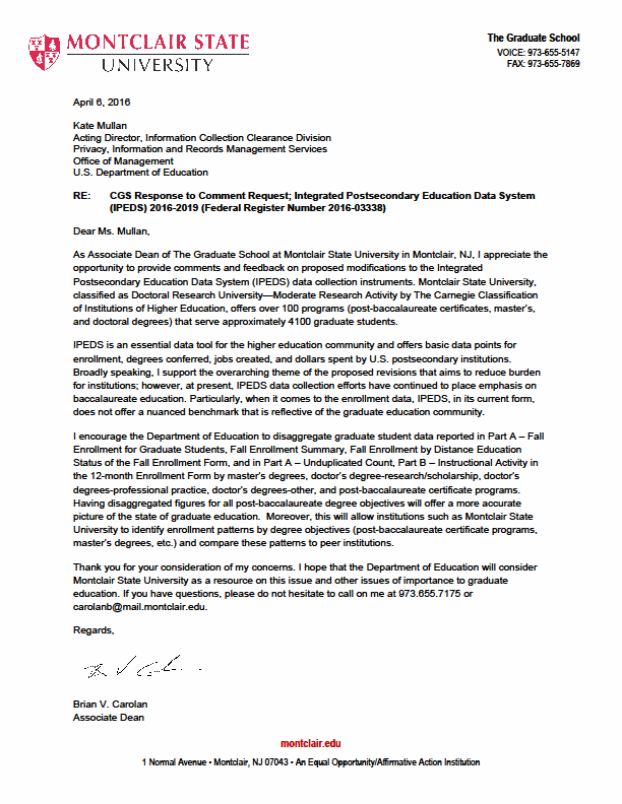
Document:
ED-2016-ICCD-0020-0047
Name: Nancy Marcus
Response
Dear Dr. Carolan and Dr. Marcus,
Thank you for your feedback dated April 8 and April 18, 2016, responding to a request for comments on proposed changes to the Department of Education’s Integrated Postsecondary Education Data System (IPEDS) published in the Federal Register. The National Center for Education Statistics (NCES) appreciates your interest in IPEDS. The Paperwork Reduction Act (PRA) provides an opportunity for an open and public comment period where comments on collections can be made. We are grateful for this process and your comment.
In regard to your comment regarding your support for the overall goal to reduce burden, we appreciate the feedback and we continue to work to decrease burden for institutions whenever possible.
In regard to your comment regarding the need to disaggregate graduate student data reported in the Fall Enrollment and 12 Month Enrollment components, for this clearance process we do not have any research guide the collection of these data. We have taken note of your concern and will consider it as an area for research and development for IPEDS and appreciate your willingness to serve as a resource in this area.
Sincerely Yours,
Richard J. Reeves
Postsecondary Branch Chief
Administrative Data Division
Comments related to graduate students (Comment numbers 46, 49)
Document:
ED-2016-ICCD-0020-0046
Name:
Suzanne Ortega
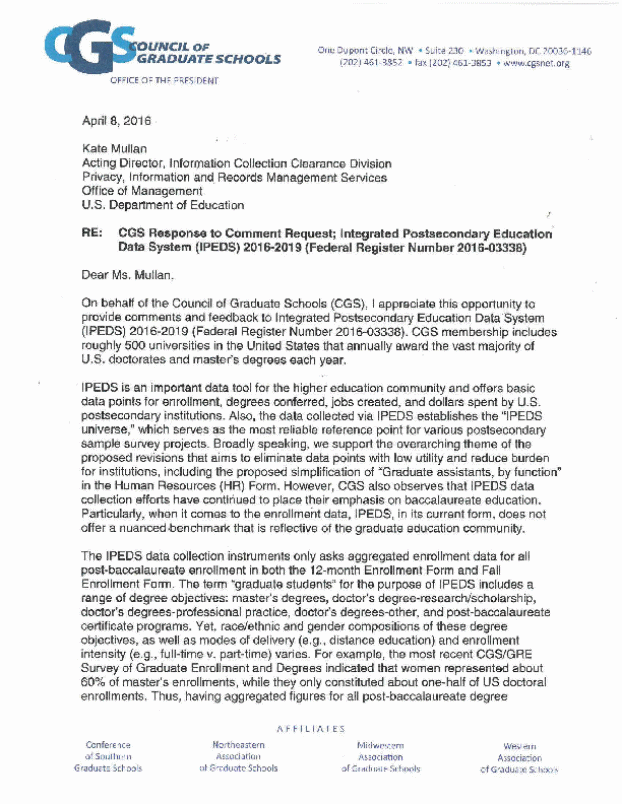
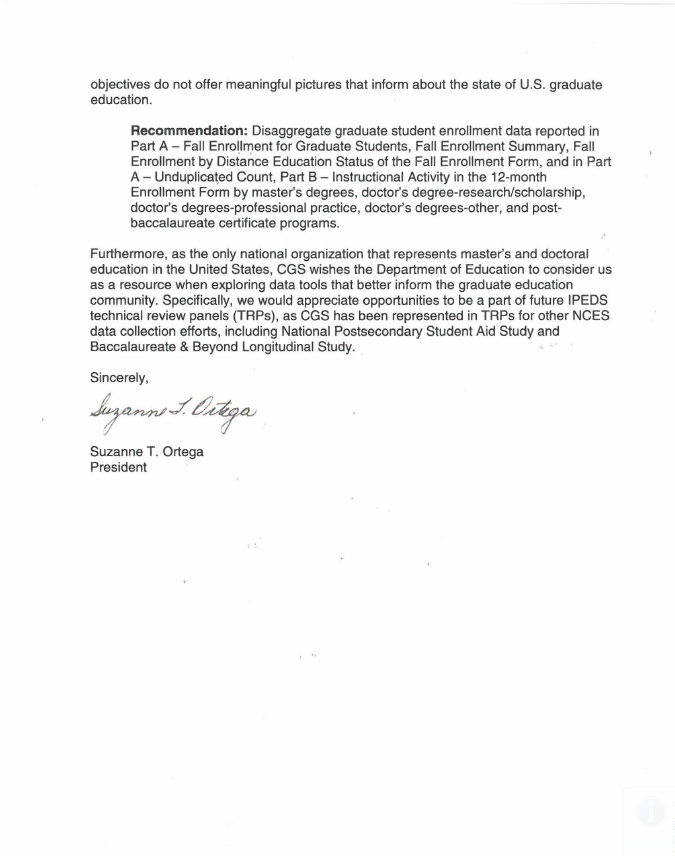
Document:
ED-2016-ICCD-0020-0049
Name: Steven Matson
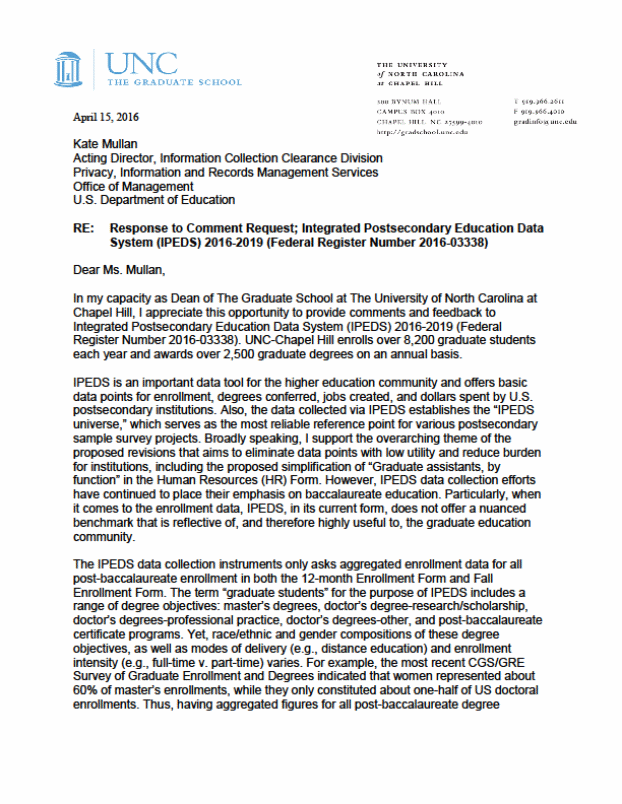
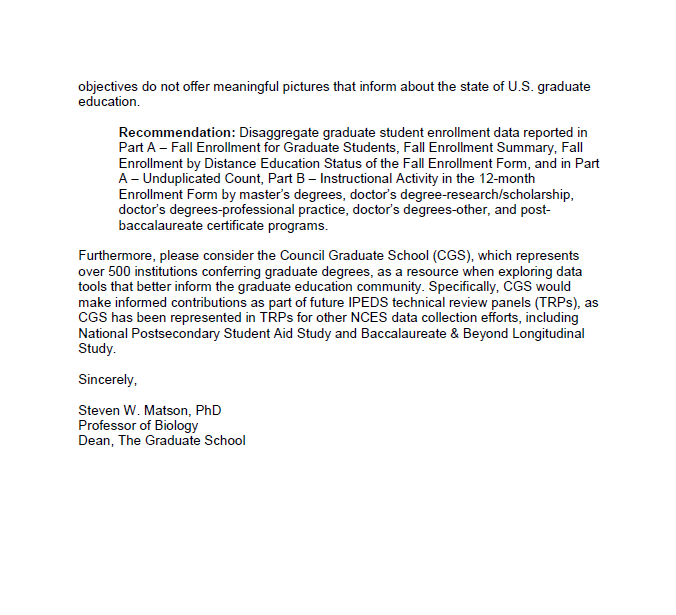
Response
Dear Drs. Ortega and Matson,
Thank you for your feedback dated April 8 and April 18, 2016, responding to a request for comments on proposed changes to the Department of Education’s Integrated Postsecondary Education Data System (IPEDS) published in the Federal Register. The National Center for Education Statistics (NCES) appreciates your interest in IPEDS. The Paperwork Reduction Act (PRA) provides an opportunity for an open and public comment period where comments on collections can be made. We are grateful for this process and your comment.
In regard to your comment regarding your support for the overall goal to reduce burden, including the changes to the “Graduate Assistants, by function” in the Human Resources component, we appreciate the feedback as we continue to work to decrease burden for institutions whenever possible.
In regard to your comment regarding the need to disaggregate graduate student data reported in the Fall Enrollment and 12 Month Enrollment components, for this clearance process we do not have any research to guide the collection of these data. We have taken note of your concern and will consider it as an area for research and development for IPEDS and appreciate your willingness to serve as a resource in this area.
Sincerely Yours,
Richard J. Reeves
Postsecondary Branch Chief
Administrative Data Division
Comment related to OM, study abroad, and ADM (Comment number 48)
Document: ED-2016-ICCD-0020-0054
Name: Joyce Smith
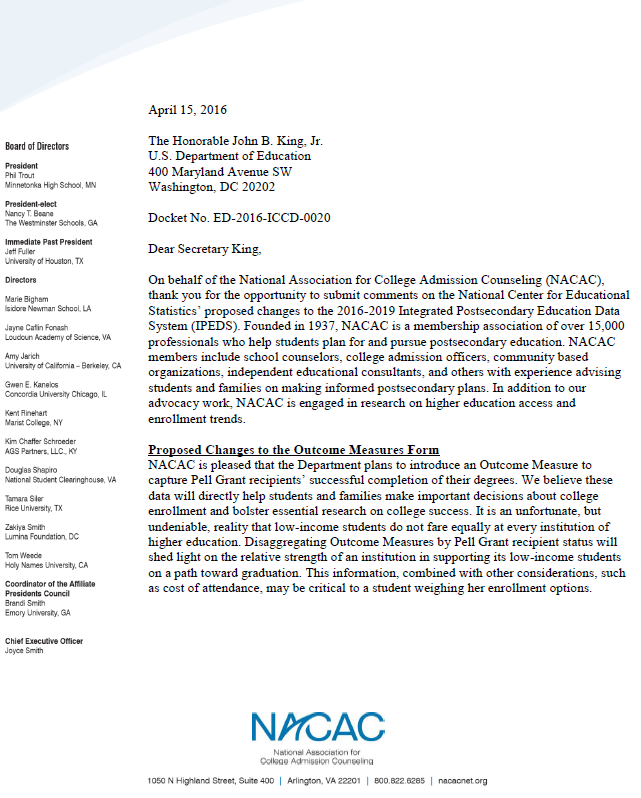
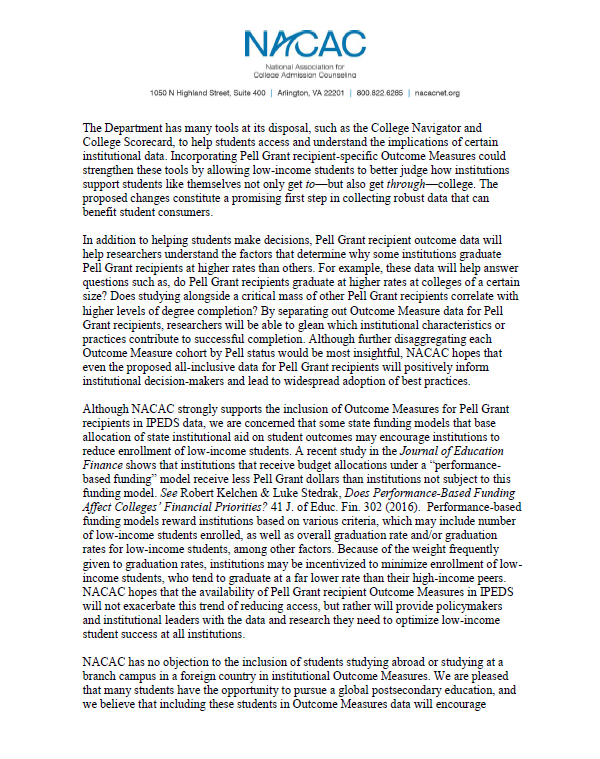
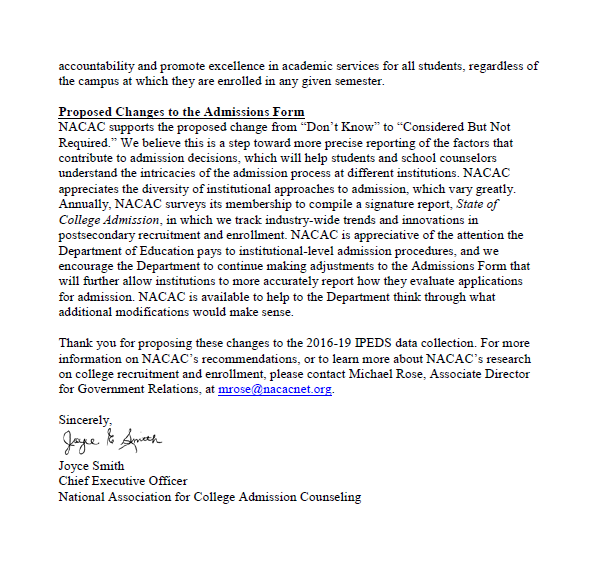
Response
Dear Ms. Smith,
Thank you for your feedback posted April 18, 2016 responding to a request for comments on proposed changes to the Department of Education’s Integrated Postsecondary Education Data System (IPEDS) 2016-19. The National Center for Education Statistics (NCES) appreciates your interest in IPEDS. The Paperwork Reduction Act (PRA) provides an opportunity for an open and public comment period where comments on collections can be made. We are grateful for this process and your comment.
The comments are 1. NACAC supports the Department’s plans to introduce an Outcome Measures to capture Pell Grant recipients’ successful completion of their degrees, 2. NACAC does not object to the inclusion of students studying abroad or studying at the branch campus in a foreign country in institutional Outcome Measures, and 3. NACAC supports the propose change from “Don’t Know” to “Considered But Not Required” on the Admissions survey component.
NCES appreciates your comments of support on the addition of the Pell Grant recipient cohort, which will provide more information on these low-income students’ success rates, and instructions to include study abroad students to the Outcome Measures (OM) survey component. Thank you also for supporting the improvements to the Admissions survey component, which will provide a better and clearer understanding of institutions’ admissions considerations.
Sincerely,
Richard J. Reeves
Postsecondary Branch Chief
Administrative Data Division
Comment related to Pell Grad Rates (Comment number 50)
Document: ED-2016-ICCD-0020-0050
Name: Edward Sullivan
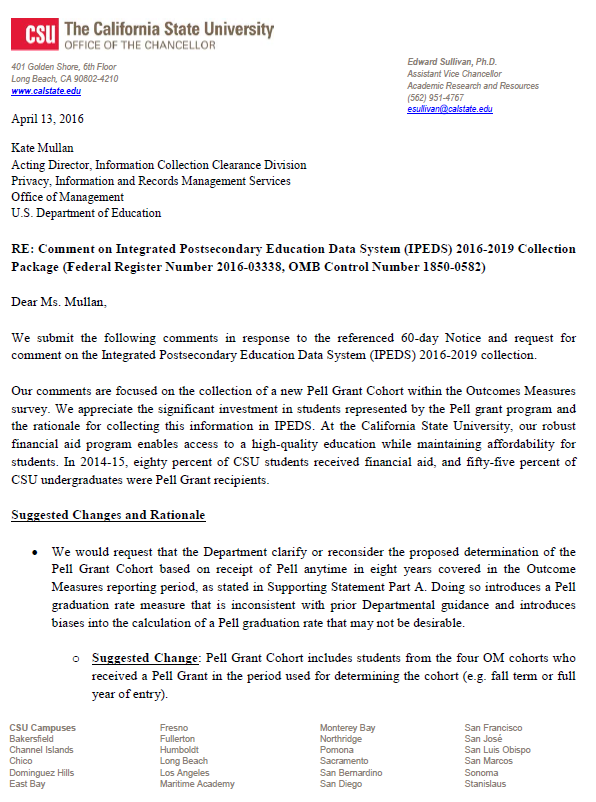
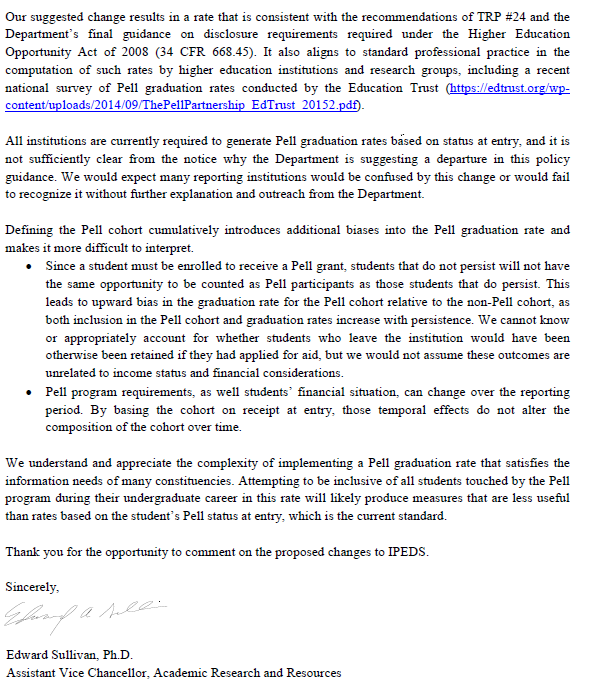
Response
Dear Dr. Sullivan,
Thank you for your feedback dated April 18, 2016 responding to a request for comments on proposed changes to the Department of Education’s Integrated Postsecondary Education Data System (IPEDS) 2016-19. The National Center for Education Statistics (NCES) appreciates your interest in IPEDS. The Paperwork Reduction Act (PRA) provides an opportunity for an open and public comment period where comments on collections can be made. We are grateful for this process and your comment.
NCES appreciates your support to begin collecting outcome data on Pell Grant recipients. We also recognize your comment to change the directions when identifying the Pell Grant recipients at point of cohort entry instead of throughout the measurement period of 8 years. However, collecting at point of entry means the data metric would be undercounting the number of Pell recipients during the 8 year measurement. In other words, NCES would not account for the students who did not receive a Pell Grant their first year, but were recipients in their successive years. Other commenters have cited that loss would be between 11% (APLU) - 25% (TICAs). As an important federal program that supports the postsecondary access of low-income Americans, we cannot afford to undercount any of these students. To ensure there is no confusion between the full-time Pell Grant graduation rate disclosure that must be disclosed by institutions, NCES will propose to include those cohort counts and resulting rates in the Graduation Rate (GR) survey with specific instructions for that collection. In addition, NCES will specify in the Outcome Measures (OM) instructions that the collected Pell data are not the Pell Grant disclosure rates that will be collected in GR survey, and further make clarification between the proposed GR 150% Pell Cohort disclosure rate and OM Pell Grant completion rates at 6 years and 8years.
Sincerely Yours,
Richard J. Reeves
Postsecondary Branch Chief
Administrative Data Division
Comments related to Pell Cohort in Outcome Measures Comments 51, 52, 55, 59, 60
Document:
ED-2016-ICCD-0020-0051
Name:
Christine Keller
Please
see the attached letter from the Association of Public &
Land-grant Universities in response to the proposed addition of a
Pell Grant recipient cohort to the Outcome Measures (OM) Survey
component of the Integrated Postsecondary Education Data System
(IPEDS).
For questions, please contact Christine Keller
at [email protected].
Thank you.
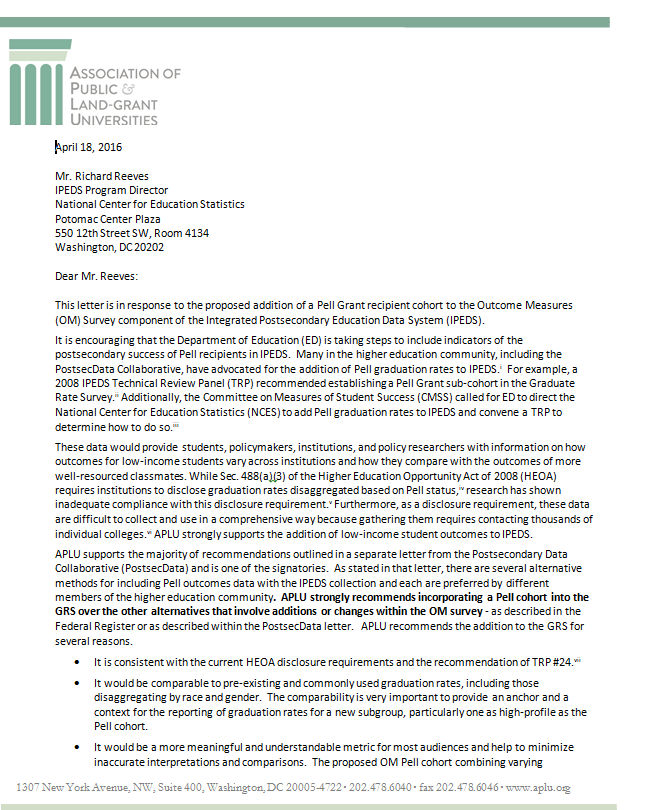


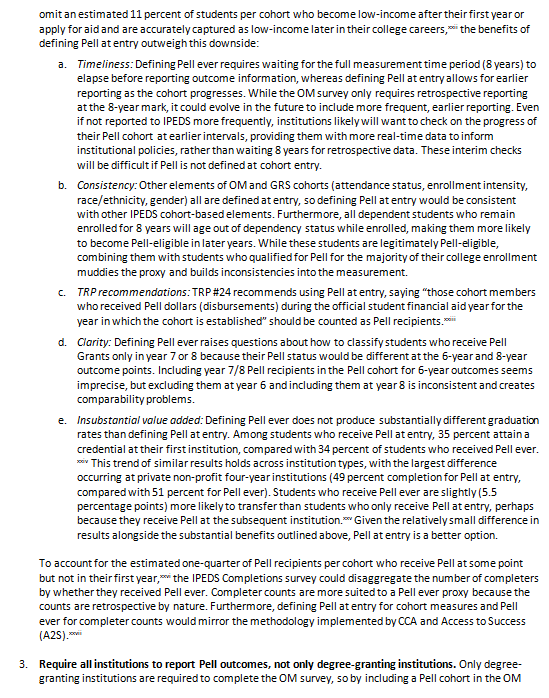
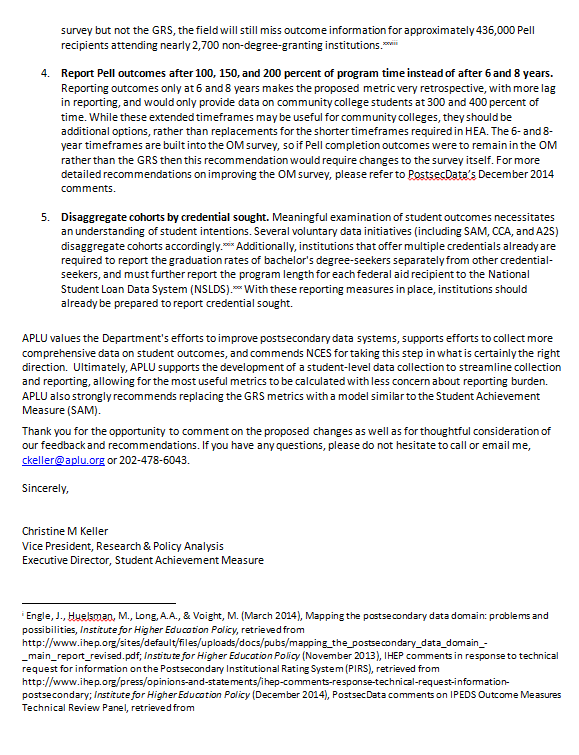
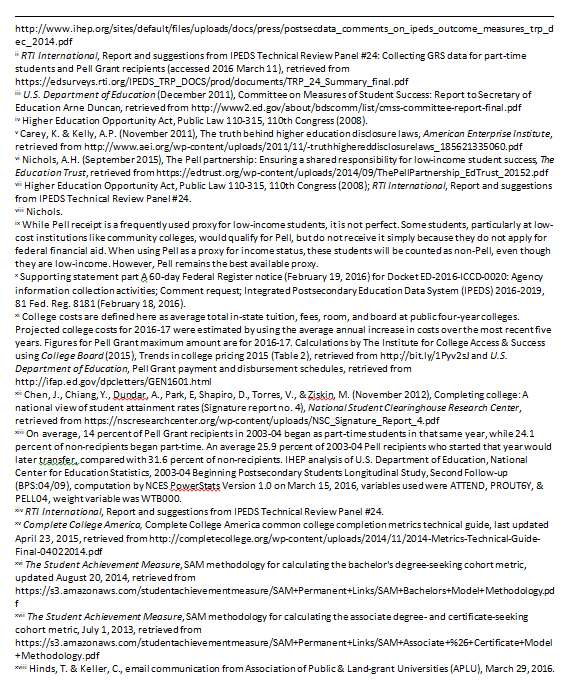
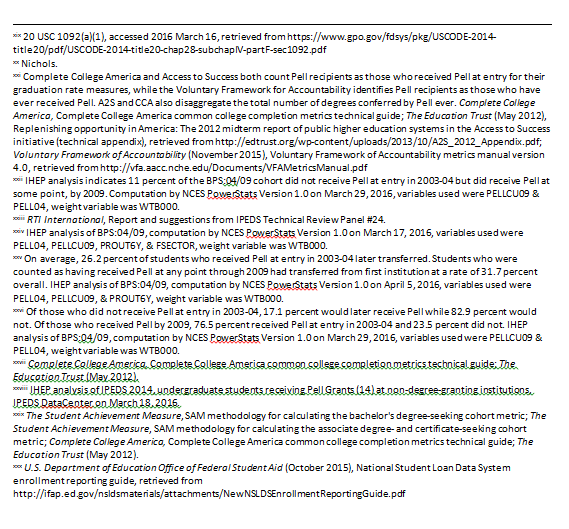
Document:
ED-2016-ICCD-0020-0052
Name:
Kati Haycock
Attached, please find comments from the Education Trust.

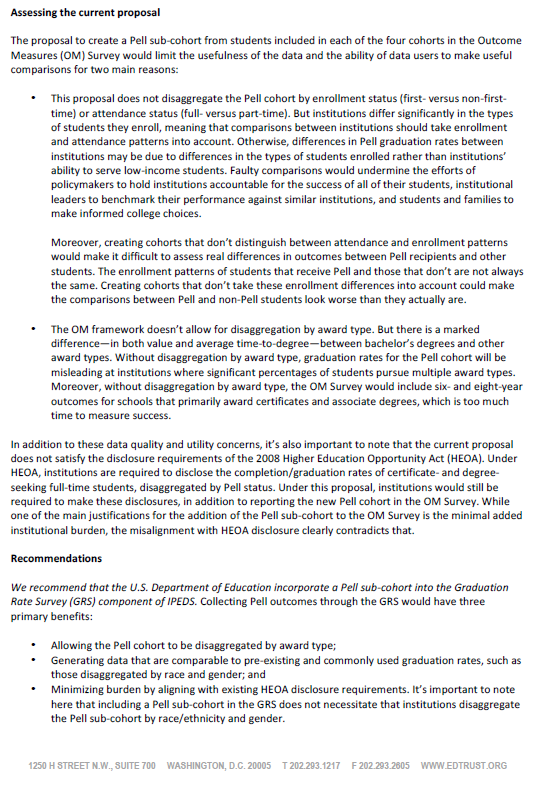
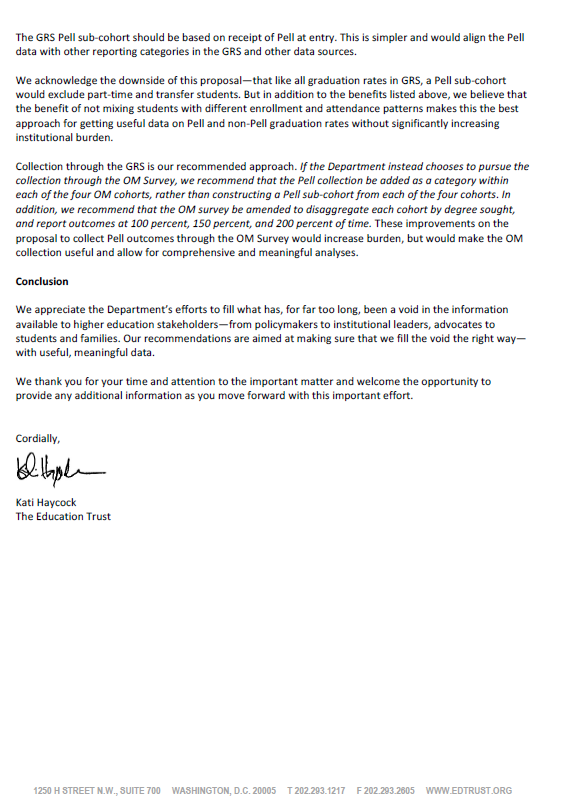
Document:
ED-2016-ICCD-0020-0055
Name:
Mamie Voight
Attached is a letter from the Postsecondary Data Collaborative in response to the proposed addition of a Pell Grant recipient cohort to the Outcomes Measures Survey component of the Integrated Postsecondary Education Data System
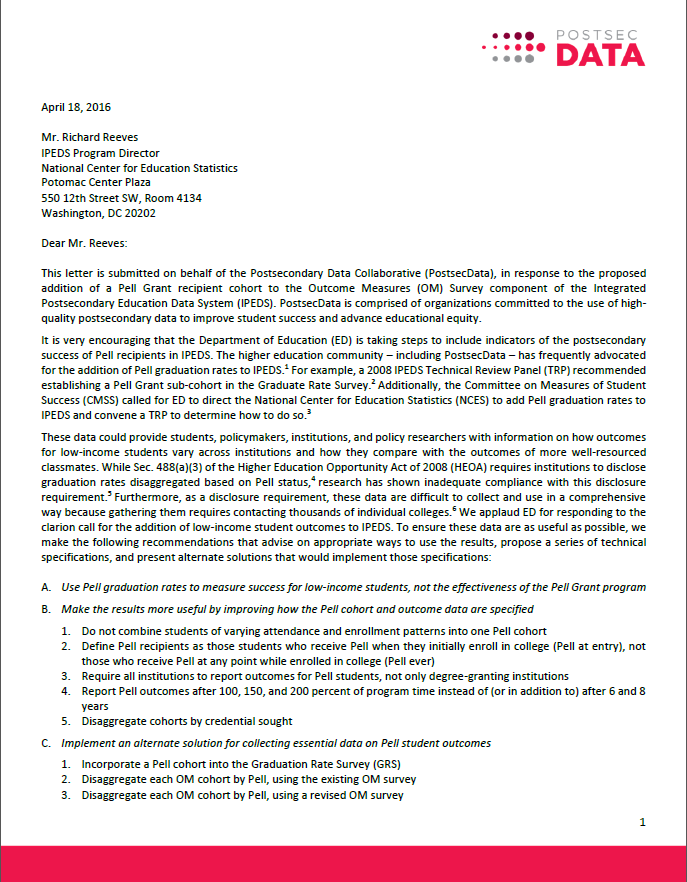

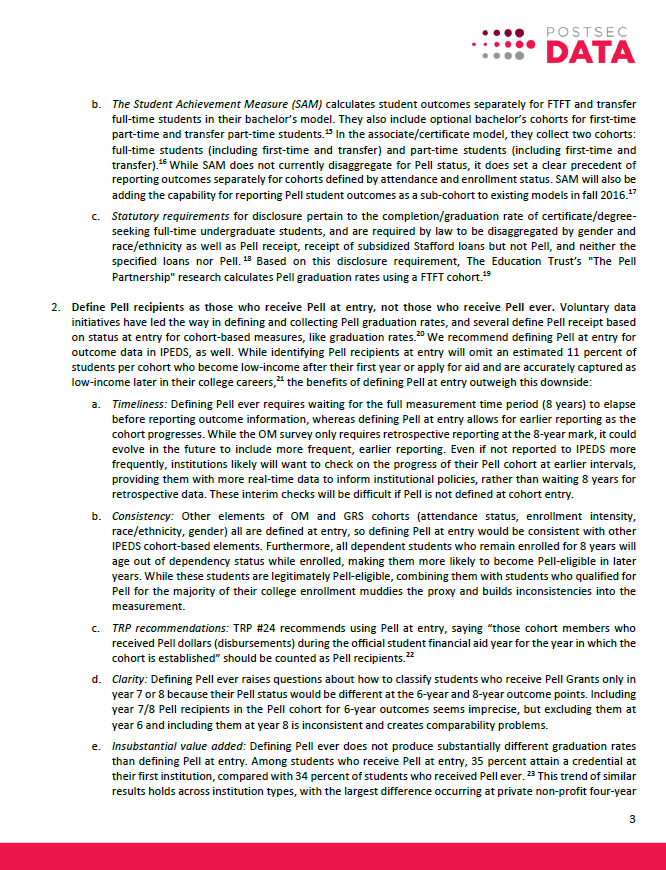
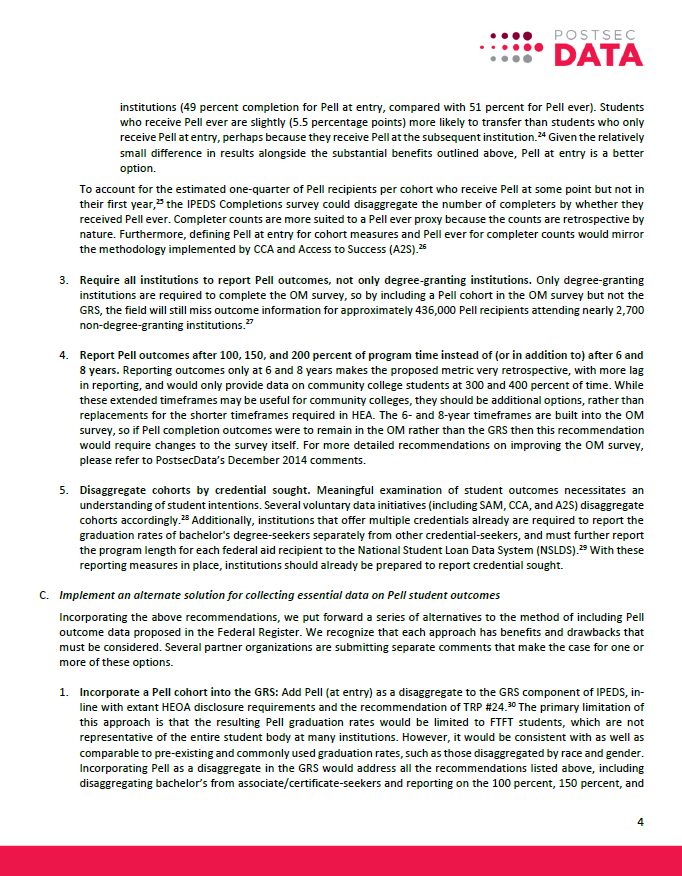
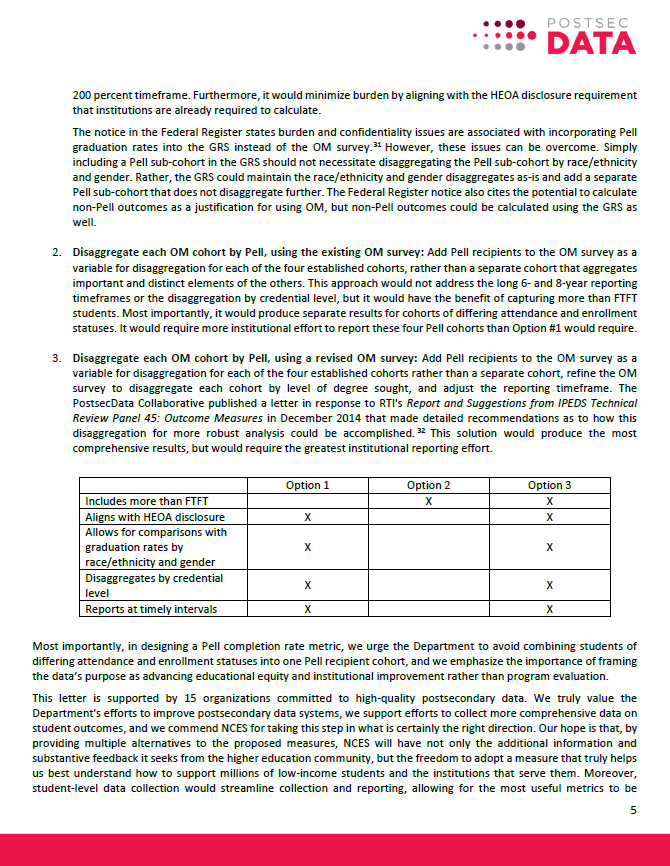
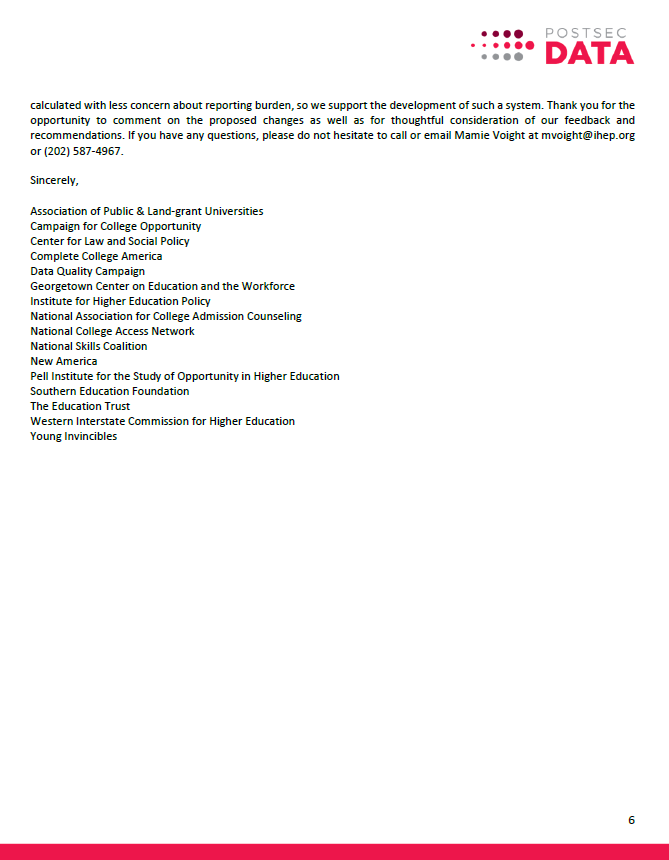
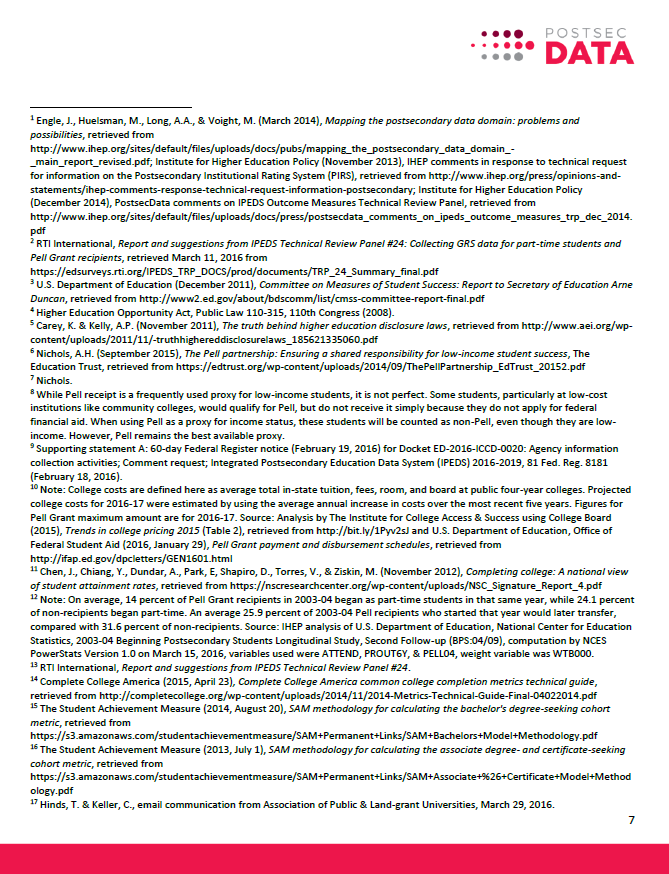
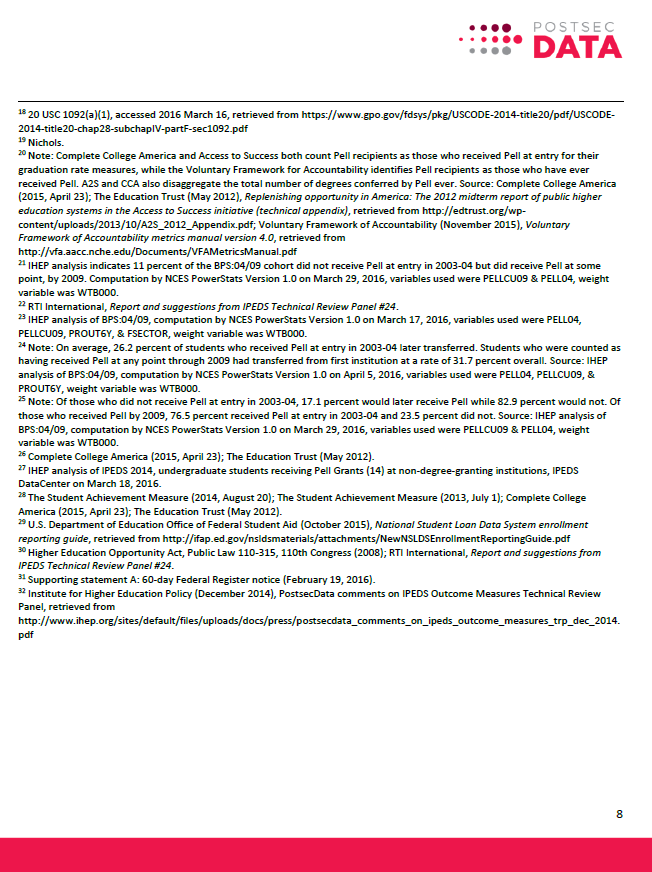
Document:
ED-2016-ICCD-0020-0059
Name:
Antoinette Flores
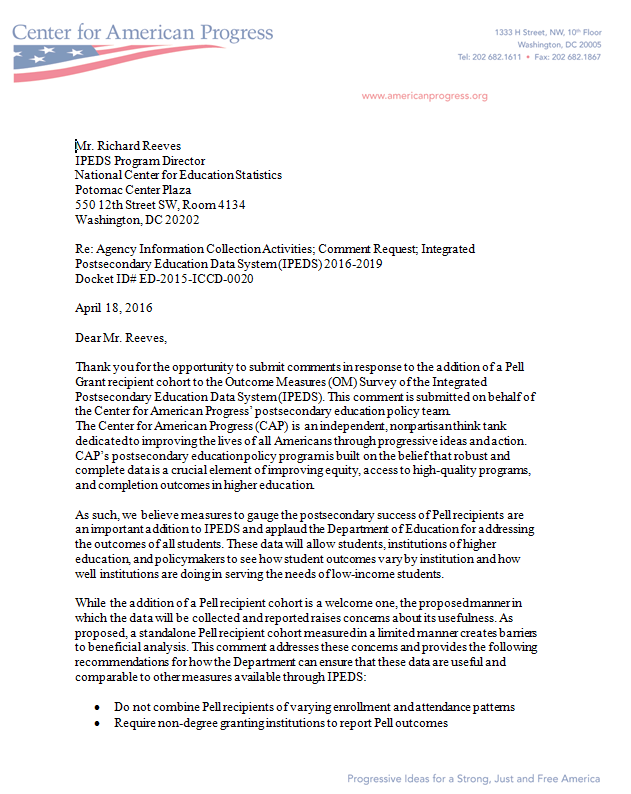
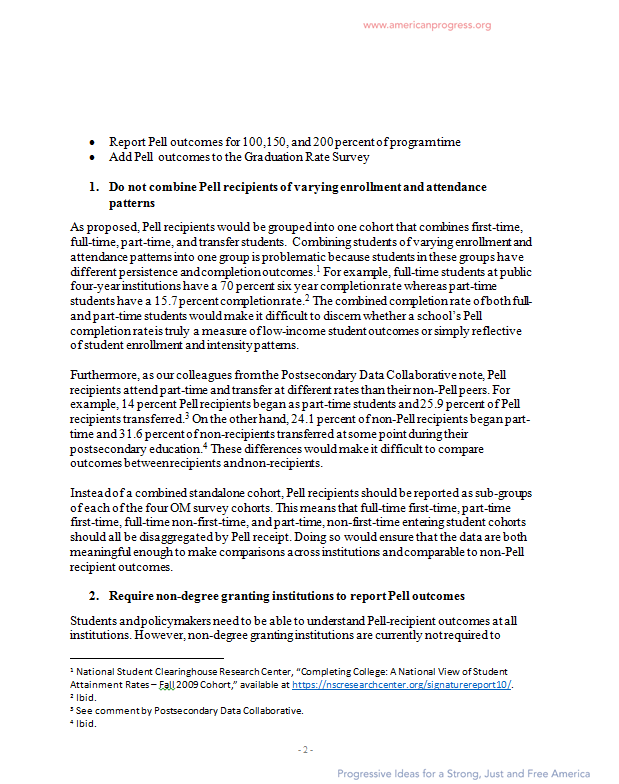
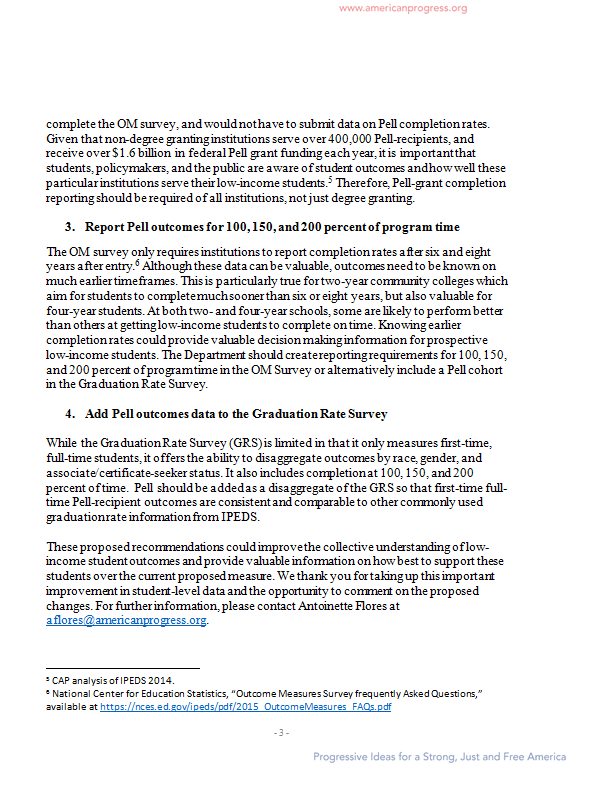
Document:
ED-2016-ICCD-0020-0060
Name:
Katie Zaback

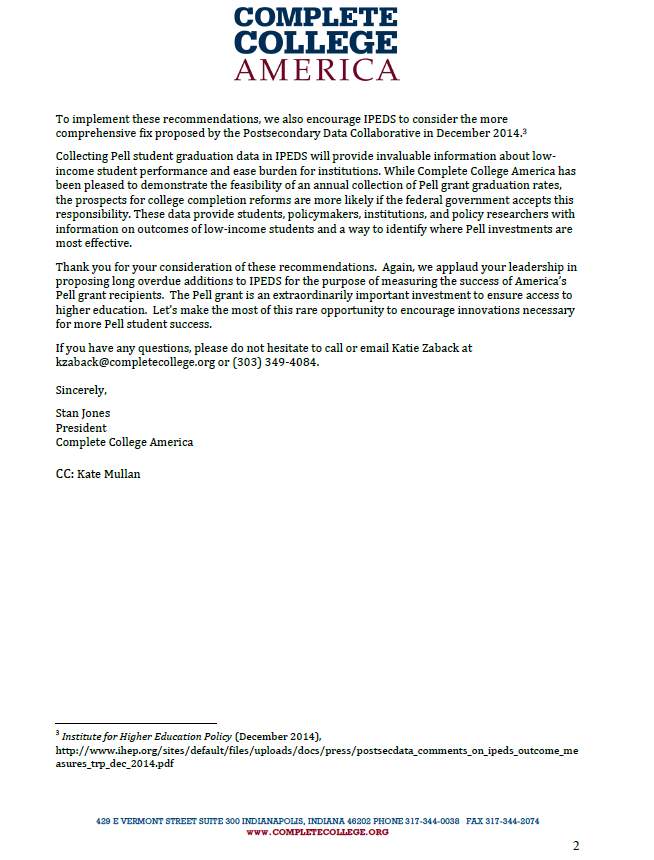
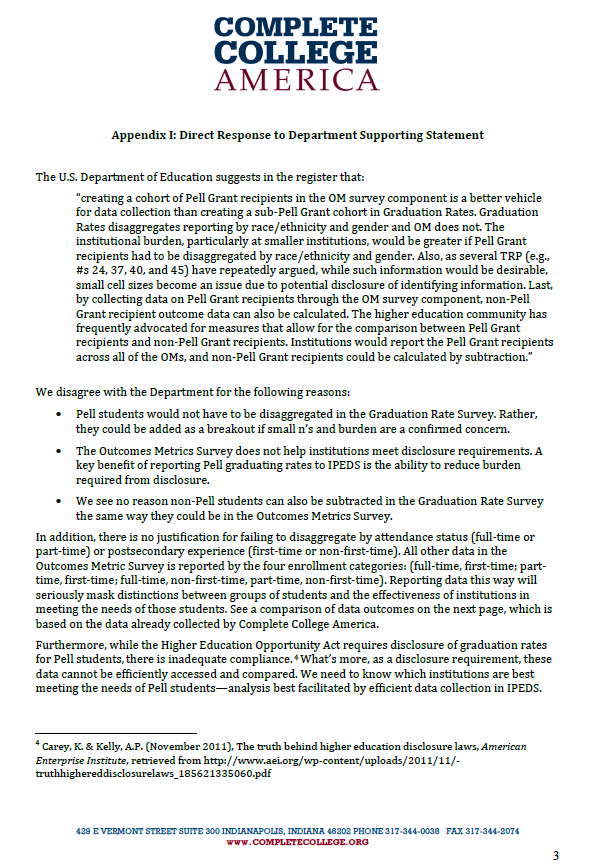
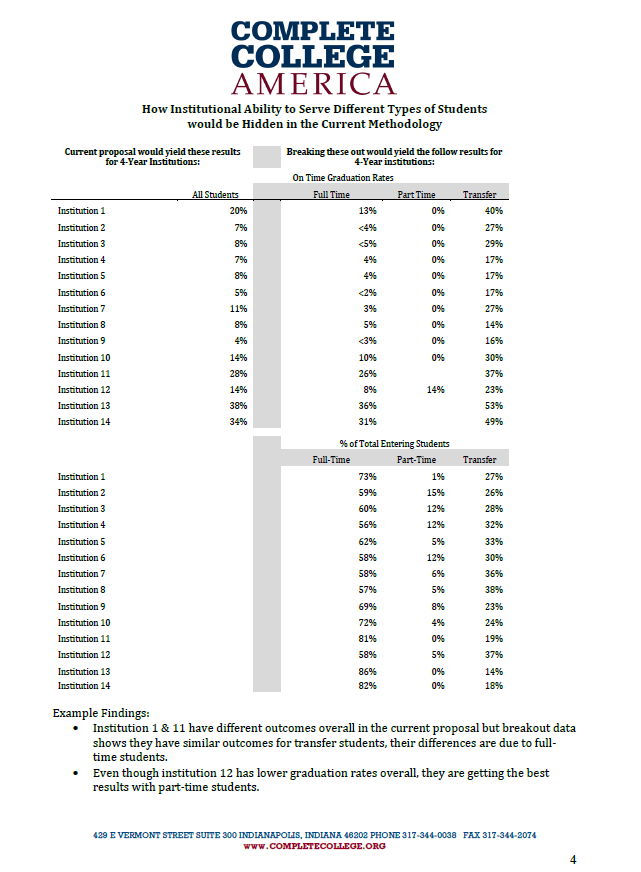
Comment related to removing Pell OM Cohort (Comment number 54)
Document:
ED-2016-ICCD-0020-0054
Name:
Kent Phillippe

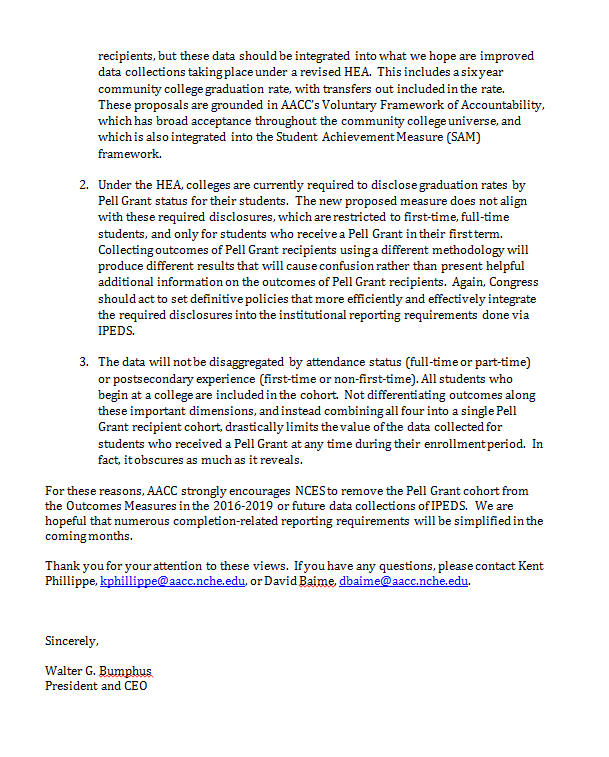
Comment related to disaggregating OM cohort by Pell (Comment number 61)
Document:
ED-2016-ICCD-0020-0061
Name:
Anonymous

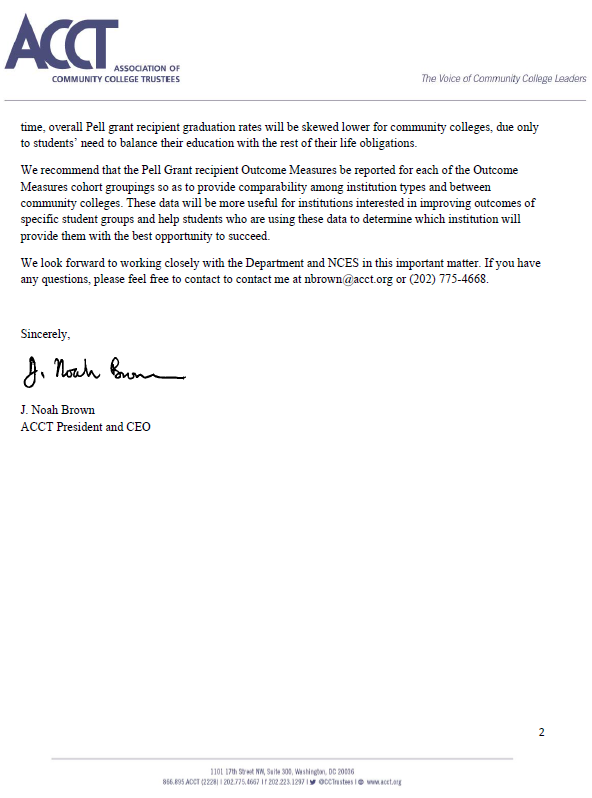
Comment related to disaggregating OM cohort by Pell (Comment number 63)
Document:
ED-2016-ICCD-0020-0063
Name:
Lindsay Ahlman
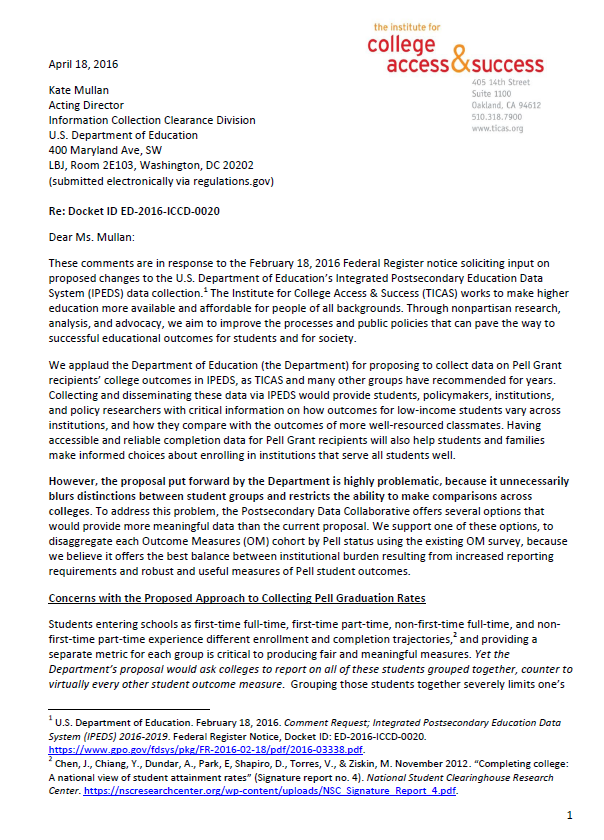
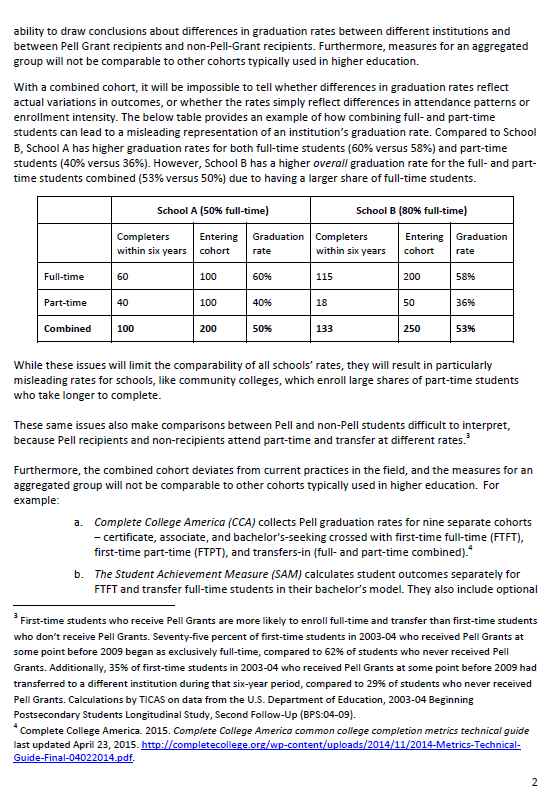
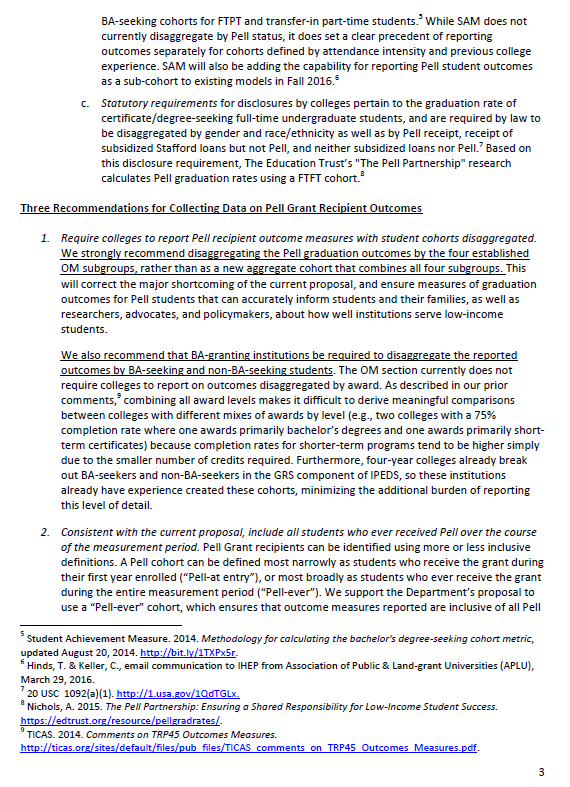


Response
Dear Ms. Keller (APLU), Ms. Haycock (Education Trust), Ms. Voight (Postsec Data Collaborative), Ms. Flores (Center for American Progress), Mr. Jones and Ms. Zaback (Complete College America), Mr. Bumphus (American Association of Community Colleges), Mr. Brown (Association of Community College Trustees), and Ms. Ahlman (The Institute for College Access and Success),
Thank you for your feedback responding to a request for comments on proposed changes to the Department of Education’s Integrated Postsecondary Education Data System (IPEDS) 2016-19. The National Center for Education Statistics (NCES) appreciates your interest in IPEDS and the very detailed and compelling set of recommendations sent by you on behalf of your organizations. The Paperwork Reduction Act (PRA) provides an opportunity for an open and public comment period where comments on collections can be made. We are grateful for this process and your comments.
NCES recognizes these commenters are among the expert IPEDS data users, many of whom have been invited to participate and comment in the IPEDS Technical Review Panels (TRP) that serve as the source for making changes to the IPEDS data collection. Each organization submitted similar recommendations related to the OM survey. As such, NCES has organized one response grouping together the recommendations.
Based on the comments from this Federal Register Notice, NCES plans to hold a TRP in August of 2016 to allow a representative group of higher education institutions and data users to review a new OM survey component with Pell Grant cohorts for each of the four cohorts and possibly to be completed by all institutions. At this time NCES believes that the expansion of the OM survey component to include these cohorts would benefit from broader industry input to consider survey form layout, instructions, and consistency with other parts of IPEDS. NCES has been in contact with OMB and are in agreement that a subsequent IPEDS package will be submitted in the fall of 2016 to address the input that will made during the August 2016 TRP and in response to its report.
Many commenters proposed that the Pell Grant cohort should be added to the Graduation Rates (GR) survey. NCES appreciates your support to begin collecting GR data on Pell Grant recipients and will propose the collection of the 150% graduation rate in the GR survey. As cited in several of your comments there is already legislative language that institutions should be preparing these data for the public and thus, collection within IPEDS should not pose a significant burden but will allow for a singular access to the GR 150% graduation rate for a Pell Grant cohort. Updates to the GR survey will be present in the 30-day materials, to be published in June 2016, and NCES plans to interact with the postsecondary community to create instructions for this collection during the summer of 2016 in order to allow for the collection to begin in the 2016-17 collection cycle.
We also recognize your comment to change the directions when identifying the Pell Grant recipients at point of cohort entry instead of throughout the measurement period of 8 years. However, collecting at point of entry means the data metric would be undercounting the number of Pell recipients during the 8 year measurement. In other words, NCES would not account for the students who did not receive a Pell Grant their first year, but were recipients in their successive years. Some commenters have cited that this would result in an undercount of somewhere between 11% (APLU) and 25% (TICAS). As an important federal program that supports the postsecondary access of low-income Americans, we cannot undercount any of these students. To ensure there is no confusion between the full-time Pell Grant disclosure graduation rates that must be disclosed by institutions, NCES will post in the Outcome Measures instructions that the collected data are not the Pell Grant disclosure rates, and further make clarification between the proposed GR 150% Pell Grant disclosure and OM Pell Grant completion rates at 6 years and 8years. This will be further discussed in the August 2016 TRP, but will remain as defined in the OM survey for now.
Sincerely Yours,
Richard J. Reeves
Postsecondary Branch Chief
Administrative Data Division
Comments related to CoA and net price (Comment number 56)
Document:
ED-2016-ICCD-0020-0056
Name:
Michael Runiewicz
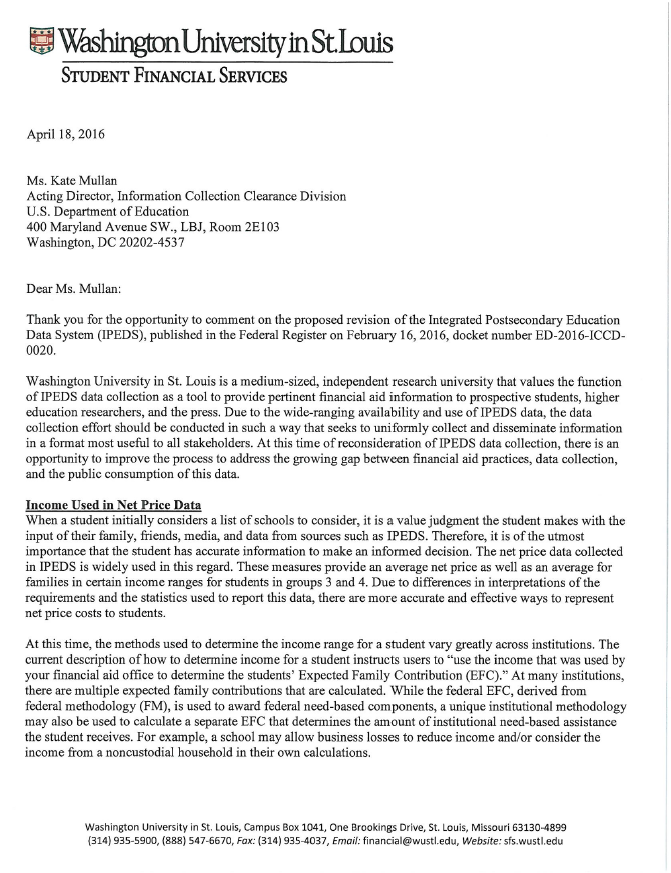
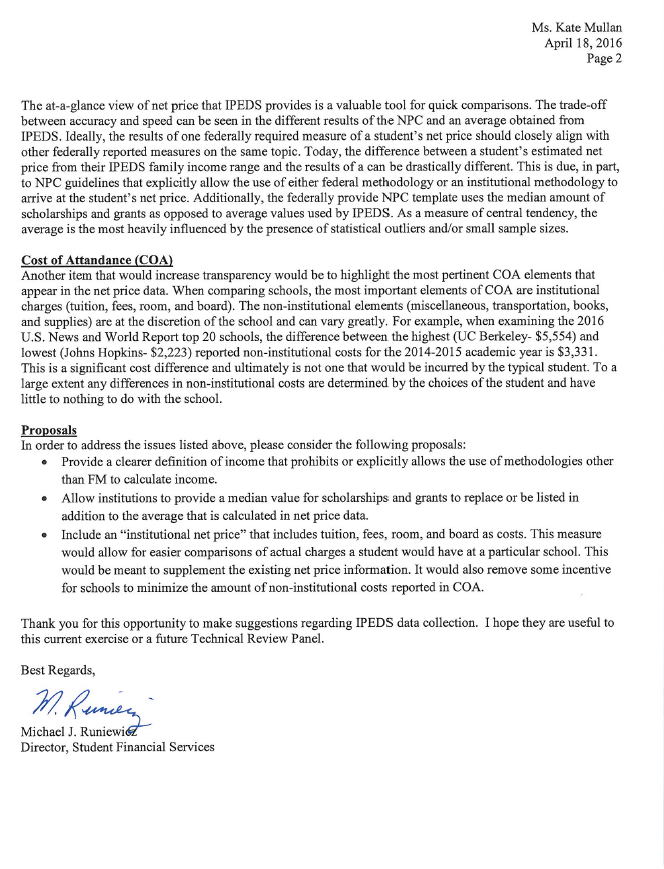
Response
Dear Mr. Runiewicz,
Thank you for your feedback posted April 19, 2016 responding to a request for comments on proposed changes to the Department of Education’s Integrated Postsecondary Education Data System (IPEDS) 2016-19. The National Center for Education Statistics (NCES) appreciates your interest in IPEDS. The Paperwork Reduction Act (PRA) provides an opportunity for an open and public comment period where comments on collections can be made. We are grateful for this process and your comment.
Thank you for submitting your comments proposing to: (1) provide a clearer definition of income that prohibits or explicitly allows the use of methodologies other than FM to calculate income; (2) allow institutions to provide a median values for scholarships and grants to replace or be listed in addition to the average that is calculated in net price data; and (3) include an “institutional net price” that included only tuition, fees, room, and board as costs.
In response to your recommendation that NCES should clearly define the method of how institutions determines Expected Family Contribution (EFC), NCES does ask that a minimal set of input elements (income, number in family, and dependency status or factors that estimate dependency status) be included in an institution’s EFC. However, NCES plans to continue to allow institutions to use either Federal Methodology or Institutional Methodology to approximate the student’s EFC because we believe that this provides flexibility in allowing institutions to ask users to provide whatever information is necessary for the institution to be able to approximate an accurate EFC for their institution. This guidance was provided to NCES through Technical Review Panels on cost of attendance and net price calculations for institutions.
In response to your suggestion to collect median values for scholarships and grants to replace or in addition to the average that is calculated in net price, NCES only collects net price based on average because it is mandated by law in Higher Education Act (HEA). HEA states, “The term ‘net price’ means the average yearly price actually charged to first-time, full-time undergraduate students receiving student aid at an institution of higher education after deducting such aid, which shall be determined by calculating the difference between – (A) the institution’s cost of attendance for the year for which the determination is made; and (B) the quotient of – (i) the total amount of need-based grant aid and merit-based grant aid, from Federal, State, and institutional sources, provided to such students enrolled in the institution for such year; and (ii) the total number of such students receiving such need-based grant aid or merit-based grant aid for such year. In order not to provide additional reporting burden on the institutions, we do not require the collection of median values as well.
In response to your recommendation to include an “institutional net price” that includes only tuition, fees, room, and board as cost, NCES does not only include these categories in the calculation of cost of attendance due to guidance provided in HEA and recommendations given in Technical Review Panels (TRPs) for IPEDS. HEA states, The term ‘cost of attendance’ means the average annual cost of tuition and fees, room and board, books, supplies, and transportation for an institution of higher education for a first-time, full-time undergraduate student enrolled in the institution. The calculation of COA expanded to also include other expenses (personal expenses, transportation, etc.) in TRP #26 “Requirements of Higher Education Opportunity Act: Multi-Year Tuition Calculator and Net Price Calculator Template,” which allows institutions to accurately calculate their COA based on additional factors that might influence costs. We believe that the current instructions for reporting cost of attendance and net price reflect what is required by law in HEA and the guidance given in TRPs and should provide for accurate and quality data being reported. Thank you again for your feedback.
Sincerely Yours,
Richard J. Reeves
Postsecondary Branch Chief
Administrative Data Division
Comments related to changes to Finance (Comment numbers 57, 64)
Document: ED-2016-ICCD-0020-0057
Name:
Susan Menditto
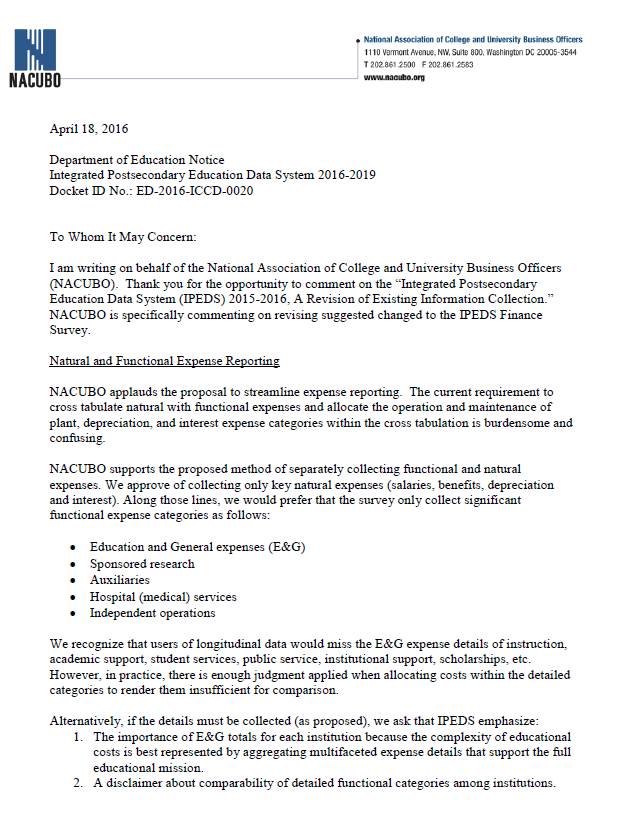
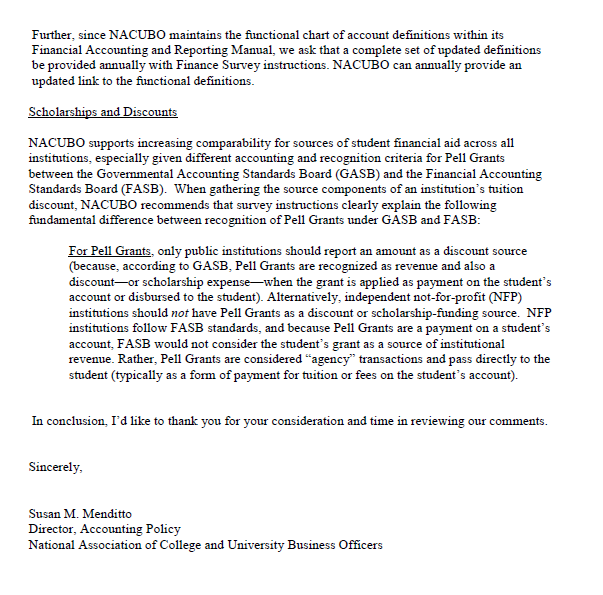
Document: ED-2016-ICCD-0020-0064
Name:
Susan Menditto
This letter is an addendum that augments NACUBO's comments submitted during business hours on April 18, 2016 and specifically addresses proposed "scholarship and discount" information changes.
Response
Dear Ms. Menditto,
Thank you for your feedback dated April 18, 2016, on behalf of the National Association of College and University Business Officers (NACUBO), responding to a request for comments on proposed changes to the Department of Education’s Integrated Postsecondary Education Data System (IPEDS) published in the Federal Register. The National Center for Education Statistics (NCES) appreciates your interest in IPEDS. The Paperwork Reduction Act (PRA) provides an opportunity for an open and public comment period where comments on collections can be made. We are grateful for this process and your comment.
NCES appreciates NACUBO’s recommendations and support for the requested changes to the Finance survey. However, we will decline to collect functional expense for just the categories listed in the comment. IPEDS Finance data is accessed by a variety of data users; including the U.S. Census Bureau, the Bureau of Economic Analysis, other departments within the U.S. Department of Education, the Delta Cost Project, and various accrediting bodies for analysis. Several publications, including the annually published Digest of Education Statistics, also use the Finance data for long term trends in postsecondary expenditures. As such, we cannot discontinue the collection of the functional expense by the current categories and begin collection by a new set of categories.
We recognize that the allocation of expense is subjective and will follow the recommendation to emphasize this point to data users wishing to compare functional expenses across institutions. Similarly, NCES already has a tip sheet that explains in detail the fundamental difference between the recognition of Pell Grants under FASB and GASB standards (http://nces.ed.gov/ipeds/Section/fct_ipeds_finance_03072007_3), but we will make an effort to emphasize this point in the instructions and FAQs. In response to the recommendation to update functional expense category definitions annually using the NACUBO Financial and Accounting Manual, this is not feasible because changes to the survey require approval from the Office of Management and Budget (OMB). Neither NCES nor OMB will have the resources sufficient to complete an approval process annually.
NCES has worked with NACUBO in the past to ensure that collected fields will not place too much additional burden on institutions and the industry and will continue to work with NACUBO to determine whether addition of the new fields collecting sources of discounts will be problematic for data reporters. If current software systems for a substantial number of institutions do not support reporting of the discount sources, NCES will consider removing the additional requested fields. Again, we thank you for the feedback and look forward to working with your organization.
Sincerely Yours,
Richard J. Reeves
Postsecondary Branch Chief
Administrative Data Division
Comments related to emphasizing E12 over EF (Comment numbers 58, 65)
Document: ED-2016-ICCD-0020-0058
Name:
Dennis Devery
The
Division could enhance the quality, utility and clarity of the
information to be collected if it eliminated or adjusted the Fall
Enrollment data collection.
Currently
fall enrollment data is a snap shot of enrollments, usually on a
specific date 15 October, that is then reported in multiple
government and non-governmental arenas.
The
problem is that these enrollment figures are a fraction of the actual
total enrollments for many colleges and universities across the
nation. Non-Traditional students now make up
a majority of
college and university enrollments and these students and their
enrollment timelines do not conform to the traditional Fall and
Spring enrollment timelines of the past. Because this data comes
early in the year and is highlighted in numerous government and
non-governmental reports it distorts the actual college and
university
enrollment situation. If the intent is to provide
enrollment data that is reflective of college and university
enrollments today then we should eliminate Fall enrollment date
collection and just use total enrollment data or highlight total (12
month enrollment data) as the primary enrollment data and use Fall
enrollment data as secondary data.
Document: ED-2016-ICCD-0020-0065
Name:
Ann Marie Senior
1) Is there still a need for this component since there is also a 12 Month Enrollment component of IPEDS?
The Fall Enrollment file collects data at a single point in time and does not accurately capture the full year enrollment counts – this is especially true for colleges and universities serving nontraditional students. Although the Fall Enrollment counts are not for the complete academic year, they are nonetheless used in high profile reports that are used to disseminate college enrollment counts to the public (e.g. College Navigator Website, IPEDS Data Center, IPEDS Data Feedback Reports, College Affordability and Transparency Center Website). This gives the impression that they reflect the full year counts when in fact they are just representing the partial year counts.
(4) How might the Department enhance the quality, utility, and clarity of the information to be
collected?
Suggestion: The 12 month file provides a truer picture of the enrollment counts of each institution and is the better way to make comparisons between institutions. Since the difference between the Fall enrollment counts and the 12 month enrollment counts varies greatly between institutions, would it be possible to only have one enrollment component that reflects the full year enrollment counts instead of the partial year? Or would it be possible that the Fall Enrollment counts not be used for public reports since they only represent a partial count of the final year end counts? The variables collected on the Fall Enrollment report are appropriate, however, the narrow time frame for snapshotting the counts does not seem to be as necessary or useful as it was when we did not have the 12 month enrollment file.
Response
Dear Mr. Devery and Ms. Senior,
Thank you for your feedback dated April 18 and 19, 2016, responding to a request for comments on proposed changes to the Department of Education’s Integrated Postsecondary Education Data System (IPEDS) published in the Federal Register. The National Center for Education Statistics (NCES) appreciates your interest in IPEDS. The Paperwork Reduction Act (PRA) provides an opportunity for an open and public comment period where comments on collections can be made. We are grateful for this process and your comment.
NCES recognizes that the student count reported in the Fall Enrollment survey may not capture the “nontraditional” students that enroll during periods of times not allotted to the fall census window. This is why we created the 12-month Enrollment survey – to capture students that enroll during other time periods of the year. However, the 12-month enrollment count is not without its weaknesses. Students who transfer during the 12-month time frame to different institutions will be counted multiple times. The Fall Enrollment count does not experience this same issue because it is a snapshot of enrollment at one particular time. As such, NCES relies on both enrollment surveys to give an accurate picture of student enrollment at postsecondary institutions. The Fall Enrollment count would better reflect enrollment at the more traditional institutions where the majority of students enroll by the fall census date. For institutions that enroll more nontraditional students, the 12-month enrollment count would better reflect their population.
While many IPEDS publications use the Fall Enrollment count, NCES has always tried to educate the higher education community and the public on the differences between the two enrollment surveys. Fall Enrollment counts are used in College Navigator because the Higher Education Act, as amended, mandated that the number of degree- or certificate-seeking undergraduates enrolled who have transferred to another institution is displayed, and this information is collected in the Fall Enrollment survey. IPEDS Data Feedback Reports are customizable while both enrollment surveys’ data are displayed in the Data Center. However, we recognize that more can be done to inform the public, so NCES is working on a brochure that will explain both the surveys and their differences. This brochure is expected to be published by the end of 2016.
Sincerely Yours,
Richard J. Reeves
Postsecondary Branch Chief
Administrative Data Division
Comment related to veteran’s benefits and definitions and instruction clarifications on SFA (Comment number 62)
Document:
ED-2016-ICCD-0020-0062
Name:
Georgia Whiddon
Regarding
(5) how might the Department minimize the burden of this collection
on the respondents:
Secure cooperation with Department of
Defense and Veteran's Affairs to assist with the collection of
veterans educational benefit information for Section 2: Military
Servicemembers and Veteran's Benefits.
Regarding (4) how
might the Department enhance the quality, utility, and clarity of the
information to be collected:
Consider moving Yellow Ribbon
matching fund data into Section 2: Military Servicemembers and
Veteran's Benefits. At least clarify the instructions regarding the
reporting of the amount of Yellow Ribbon funds matched by the
institution. It is baffling that Yellow Ribbon funding (amounts
funded either directly from the VA and/or matched by the institution)
are prohibited from being recognized and reported as Expected
Financial Assistance (EFA), and yet IPEDS is asking for this level of
data assistance in what essentially are EFA sections.
Divide
Group 1 into full-time and part-time. There may be significant
differences in costs between full-time and part-time populations, and
the current lack of identifying this distinction may lead to flawed
conclusions. Additionally, allow undergraduate populations to be
sub-divided into sub-groups based on significant differences in cost
within an institution, which will provide researchers with the
opportunities to evaluate meaningful data and reach relevant
conclusions.
Clarify definitions used throughout IPEDS
instructions to assure equitable and comparable reporting and also to
be sure that researchers are likewise fully informed of the
definitions and that they are able to understand the differences in
definitions. For example, what does it mean for a student to be
"awarded" a loan? Does this mean that the student was
offered the loan? Does it mean that they accepted the loan? Does it
mean that they received a loan disbursement? Students may be offered
a loan and accept a loan, and yet if the student fails to complete
the required steps, may never receive a disbursement of a loan. If it
is important to recognize these distinctions, then clarification is
needed.
Finally, it seems additional data which could
prove useful in research and for policy decisions may be just too
difficult to obtain, at least via IPEDS. For example, when collecting
student debt data, it would be useful to identify the portion of debt
being used towards non-tuition/fee costs (such as living expenses)
versus tuition/fee costs so that researchers may understand why
students borrow. It seems this would help not only researchers, but
also the public in understanding the reasons and use of federal loan
funds borrowed. In the current IPEDS methodology it is impossible to
address such queries. Reporting this distinction of loan use may
prove daunting for institutions, but if this is viewed as pertinent
information that would be of value, then efforts for such data
collection should be explored. Similarly, it may be useful to explore
methods of collecting student debt data for students enrolled in
programs where education delivery is for the most part via on-line.
Response
Dear Ms. Whiddon,
Thank you for your feedback posted April 19, 2016 responding to a request for comments on proposed changes to the Department of Education’s Integrated Postsecondary Education Data System (IPEDS) 2016-19. The National Center for Education Statistics (NCES) appreciates your interest in IPEDS. The Paperwork Reduction Act (PRA) provides an opportunity for an open and public comment period where comments on collections can be made. We are grateful for this process and your comment.
Thank you for submitting your comments proposing to: (1) secure cooperation with the Department of Defense and Veteran’s Affairs to assist in the collection of data for SFA Section II; (2) move Yellow Ribbon matching fund data to SFA Section II; (3) divide Group 1 in SFA to full-time and part-time; (4) clarify definitions used in IPEDS (e.g. awarded); and (5) collect student debt data.
In response to your first recommendation to secure cooperation with the Department of Defense and Veteran’s Affairs to assist in the collection of data for SFA Section II, NCES discussed this type of cooperation at Technical Review Panel (TRP) #36 “Collecting Data on Veterans.” However, TRP #36 identified the following technical issues with the VA providing data to institutions for reporting to IEPDS:
Inability of VA data to distinguish between undergraduate and graduate student beneficiaries;
Reconciling institution facility codes used by VA and UnitID used by IPEDS;
Lack of alignment in IPEDS and VA reporting periods, fluctuating variables like overpayments and underpayments that change over time, due to the transactional nature of the data system;
Duplication of data for students who attend and receive benefits at more than one facility code; and
Inability to validate data at the institution level other than Post-9/11GI Bill benefits.
Given the technical issues that were identified in the TRP discussion, the panel agreed that mapping VA data to IPEDS data for reporting to IPEDS is not feasible at this time.
In response to your second recommendation to move Yellow Ribbon matching fund data to SFA Section II, NCES does not plan to make this changes because Section II reporting is only for benefits provided directly through Post-9/11 GI Bill Benefits and Department of Defense Tuition Assistance Programs. The Yellow Ribbon program through the Post-9/11 GI Bill is an institutional aid matching program only for tuition and fees for students attending participating institutions. The institutional aid provided through the Post-9/11 GI Bill Yellow Ribbon
matching program should not be reported in the Post-9/11 GI Bill’s total dollar amount of benefits/assistances because the funding comes from the institution not directly from the benefit/assistance programs. The institution’s matching funds from the Yellow Ribbon program should be reported under institutional aid in SFA section I as it aligns with the institutional data reported in this section. The reporting instructions for Yellow Ribbon matching fund data came from guidance provided during TRP #36.
In response to your third recommendation to divide Group 1 in SFA to full-time and part-time, NCES does not plan to make this change because the Higher Education Act (HEA), as amended, requires institutions to report financial aid data for multiple groups of students (including Group 1 – all new and continuing undergraduate students). Also, dividing Group 1 into only full-time and part-time students is not feasible because this categorization would exclude degree/certificate-seeking students, non-degree/certificate seeking students, and all other students, which is a reporting requirement.
In response to your fourth recommendation to clarify definitions used in IPEDS for SFA (e.g. awarded), NCES defines terminology through the SFA instructions, glossary, and FAQs of the SFA survey package. For example, SFA provides the following FAQ, “Question: What does ‘aid awarded’ mean? Answer: Institutions should report on grant or scholarship aid that has been awarded to students. This may be different from aid that was actually disbursed to students. For example, a student may be awarded grant or scholarship aid at the beginning of the academic year but then leave the institution before the entire amount is disbursed. In this case, you would report the original amount of grant or scholarship aid that was awarded, even though the entire amount was not actually disbursed to the student. For reporting loans to students, institutions should continue to report on loans that were awarded to and accepted by the student.” However, NCES will review SFA instructions, glossary, and FAQ to ensure all terminology is clearly defined.
Finally, in response to your recommendation to collect student debt data, NCES does not collect this information because these data are collected through the Office of Federal Student Financial Aid. We believe that the current SFA data being collected and instructions for reporting should provide for accurate and quality SFA data from institutions. Thank you again for your feedback.
Sincerely Yours,
Richard J. Reeves
Postsecondary Branch Chief
Administrative Data Division
| File Type | application/vnd.openxmlformats-officedocument.wordprocessingml.document |
| Author | Authorised User |
| File Modified | 0000-00-00 |
| File Created | 2021-01-23 |
© 2025 OMB.report | Privacy Policy
